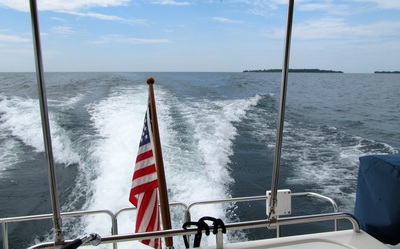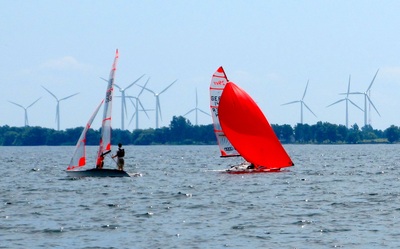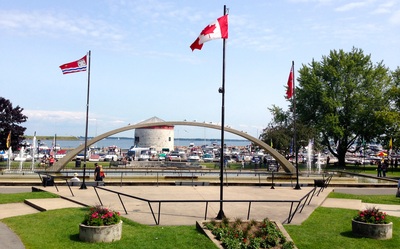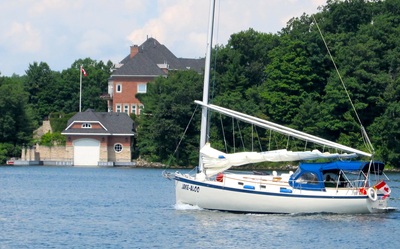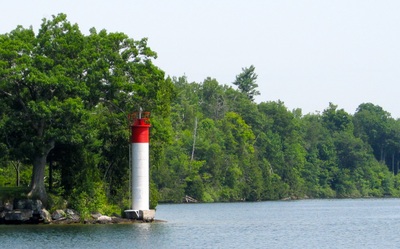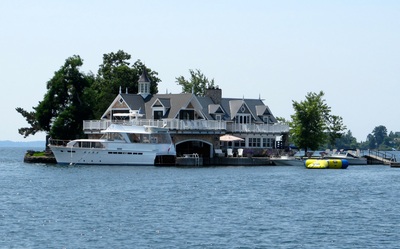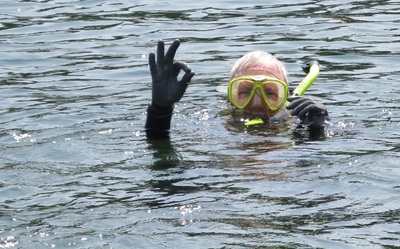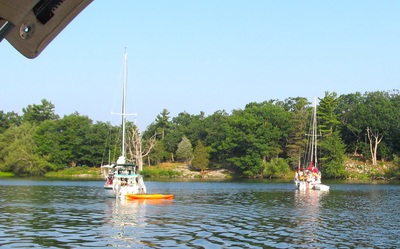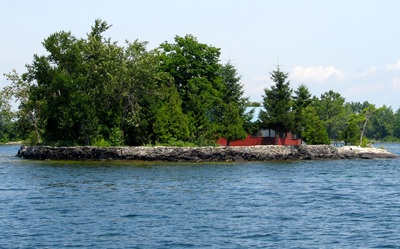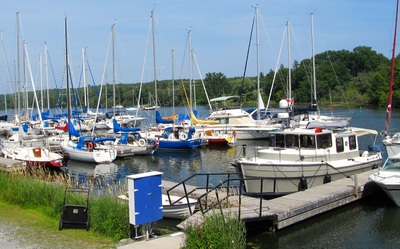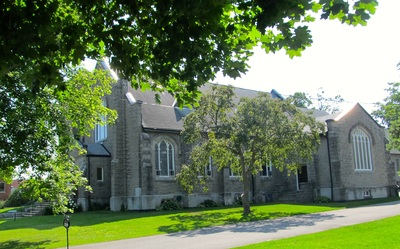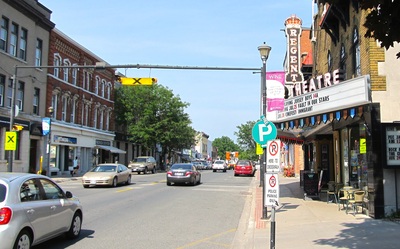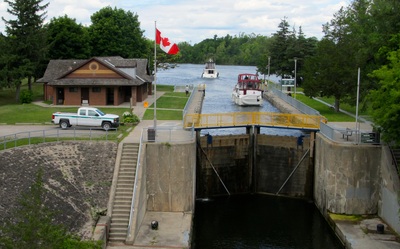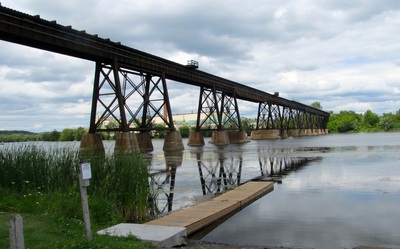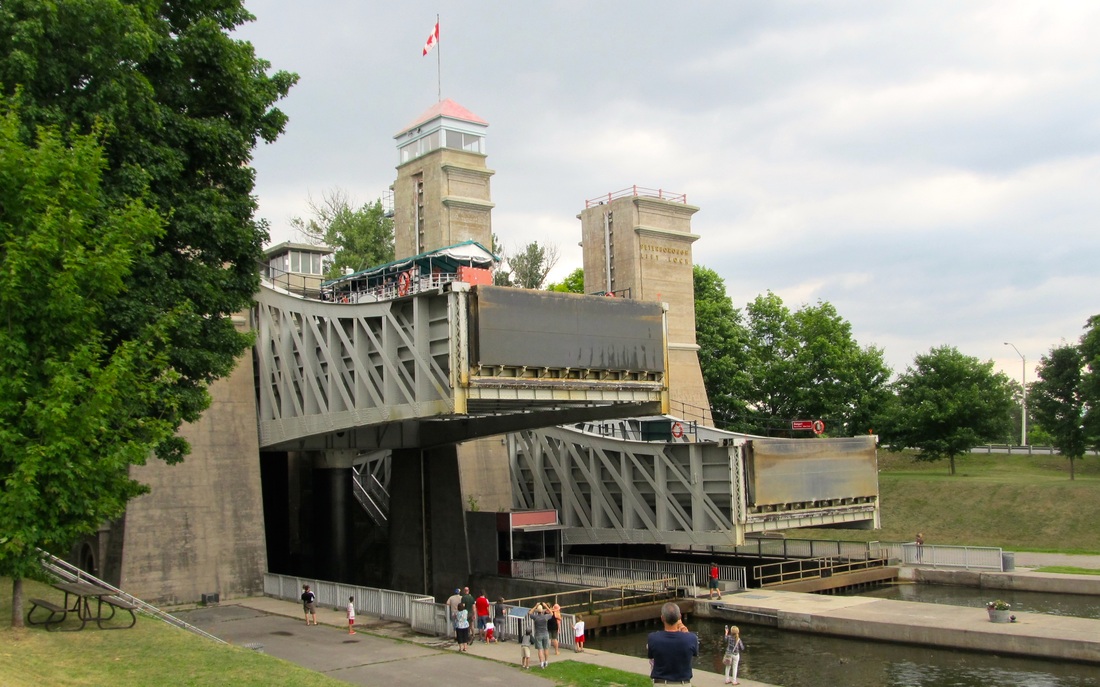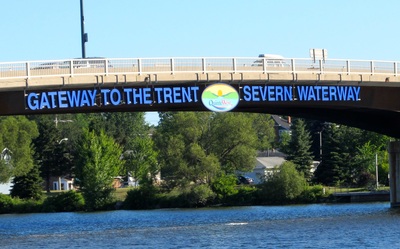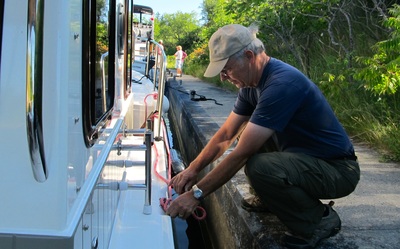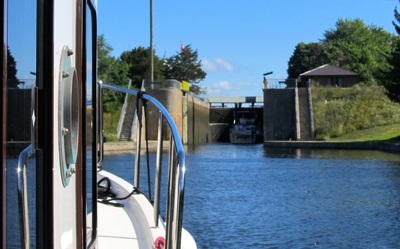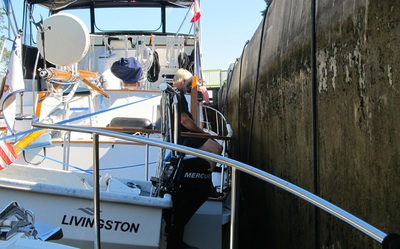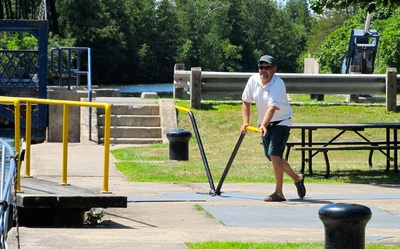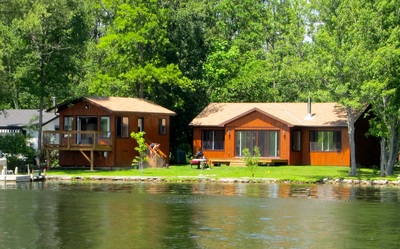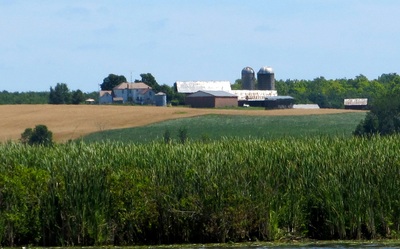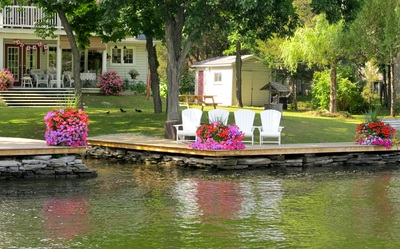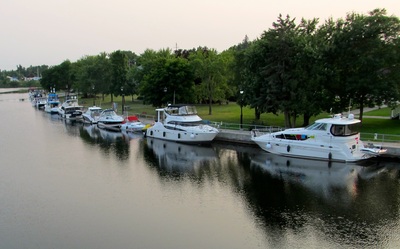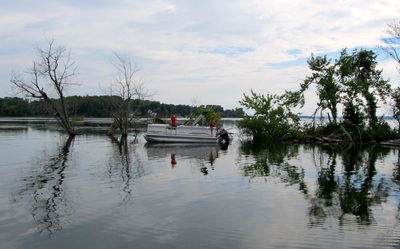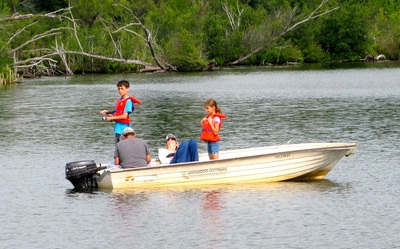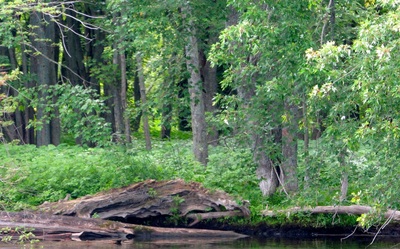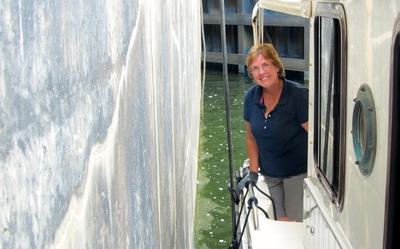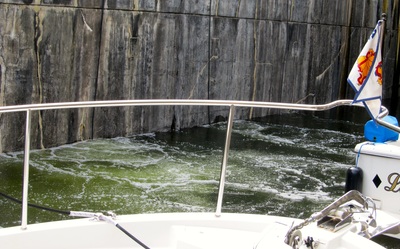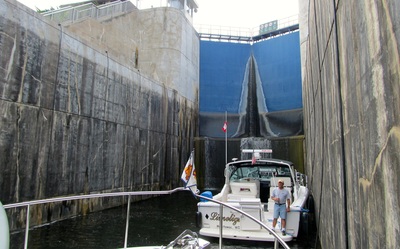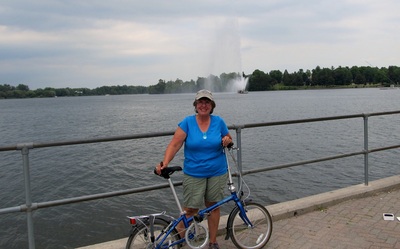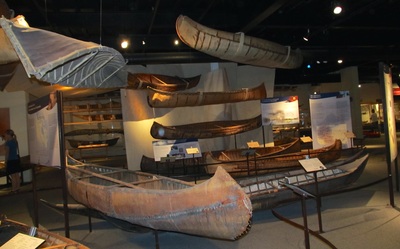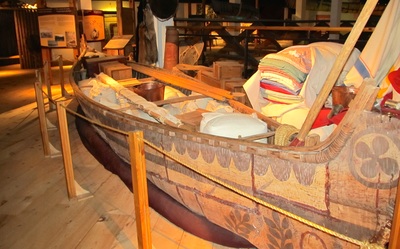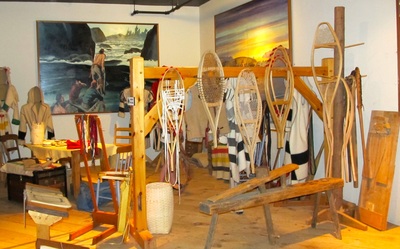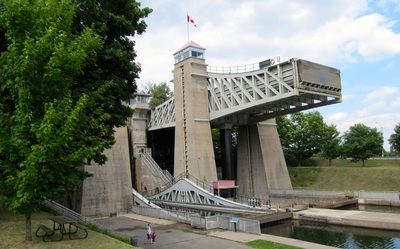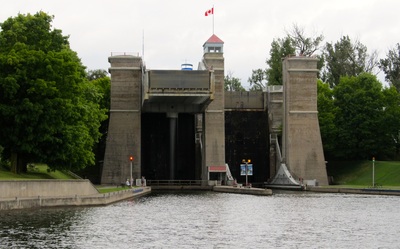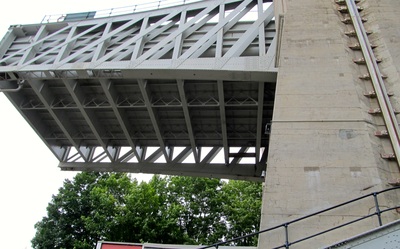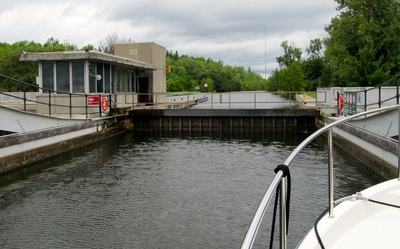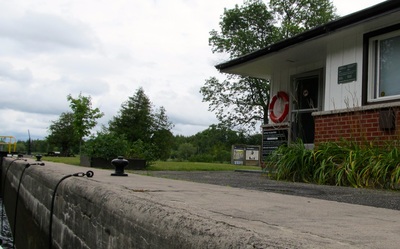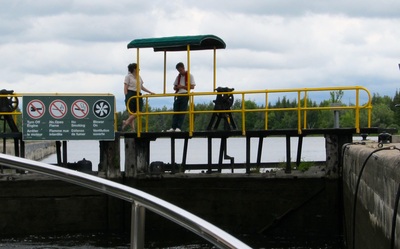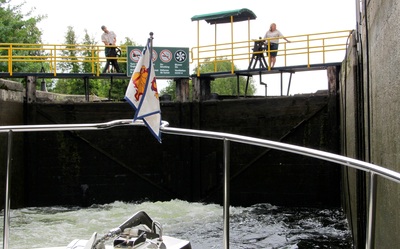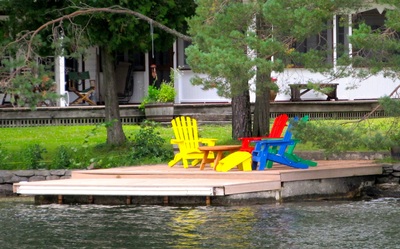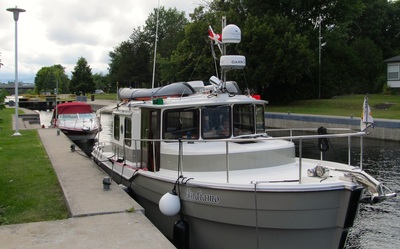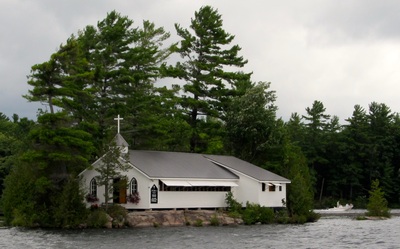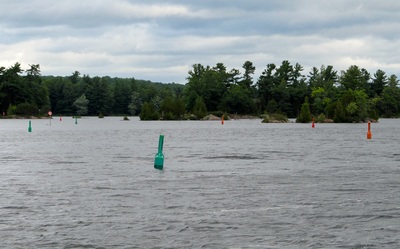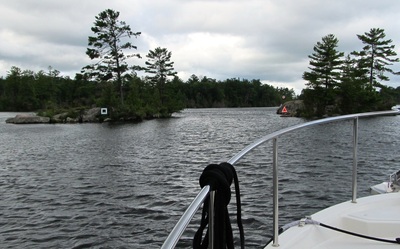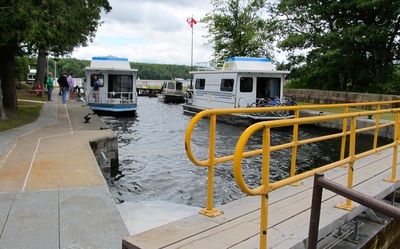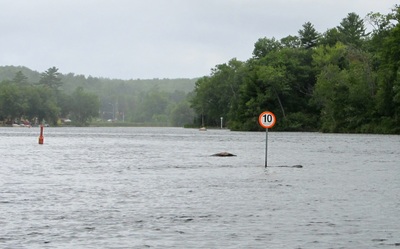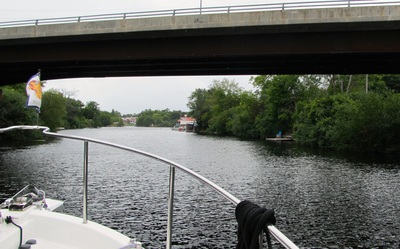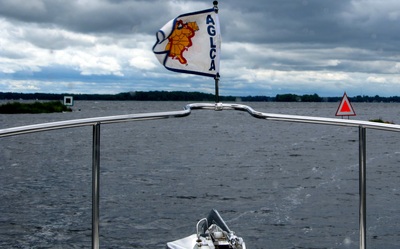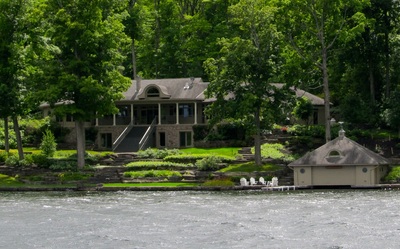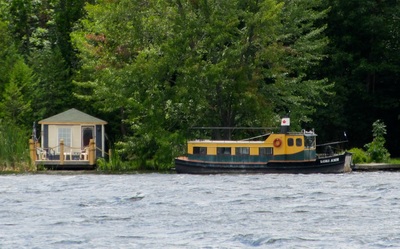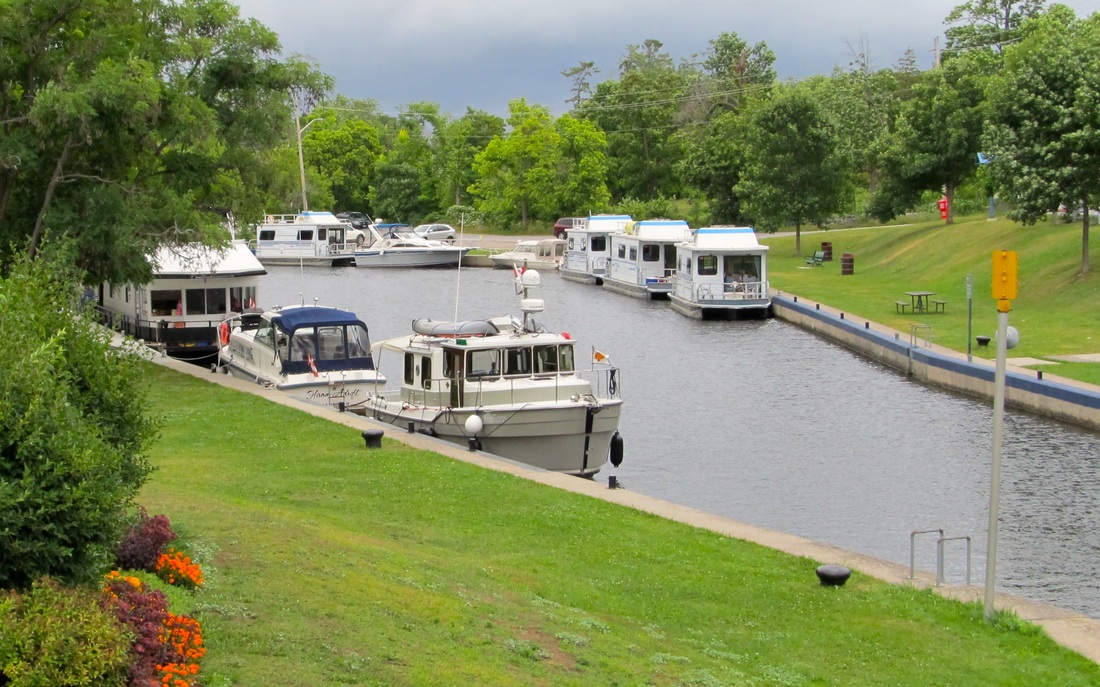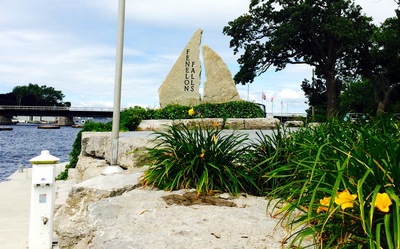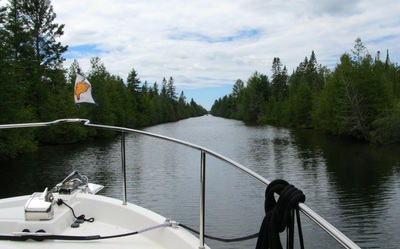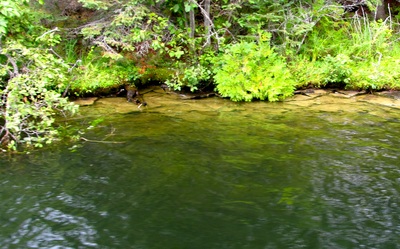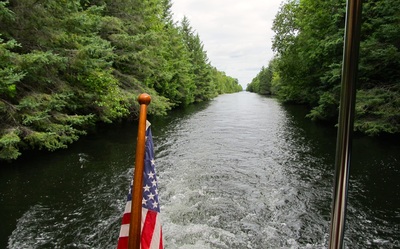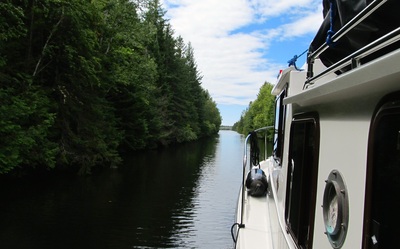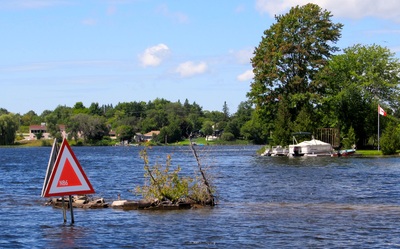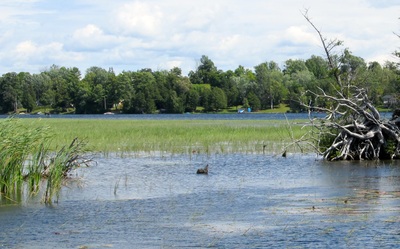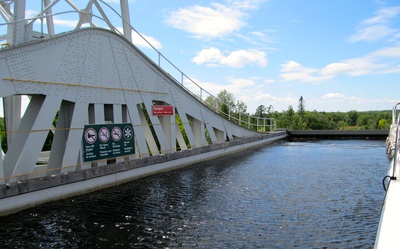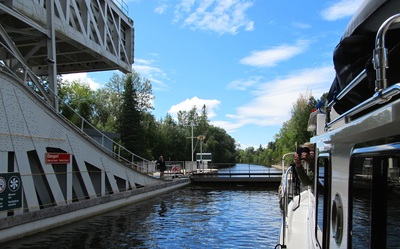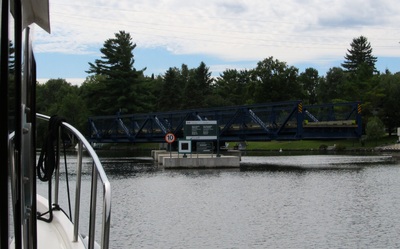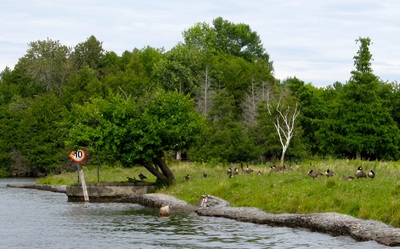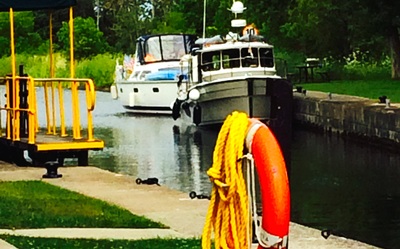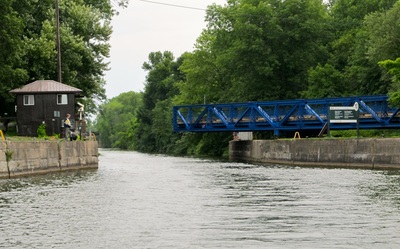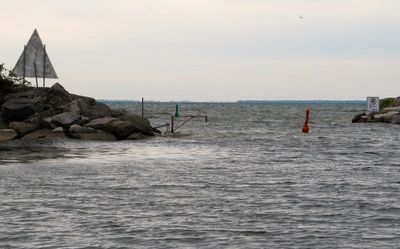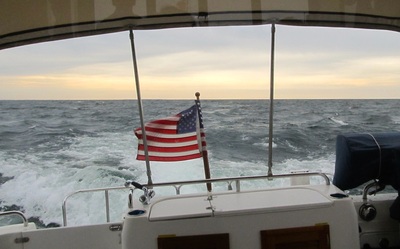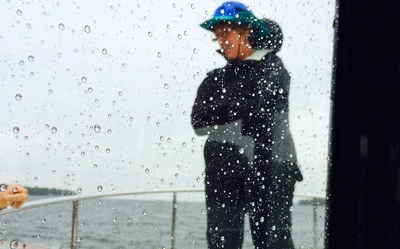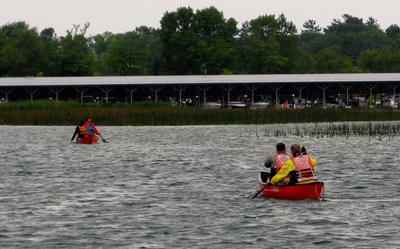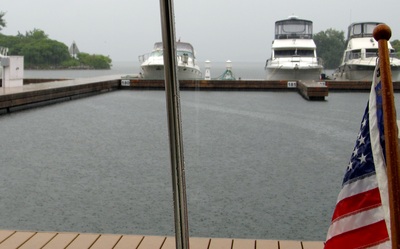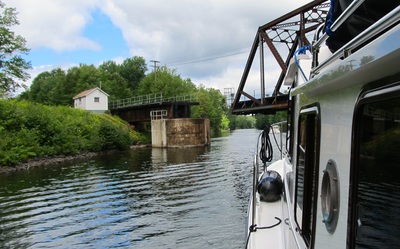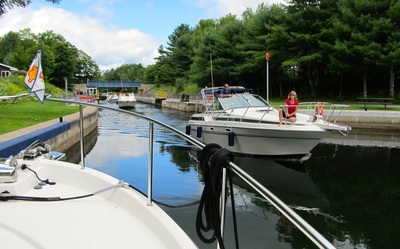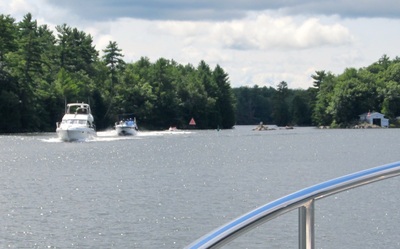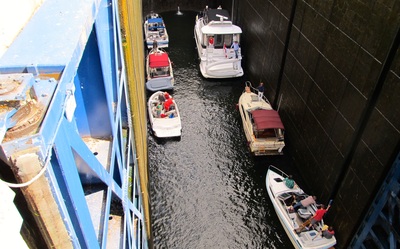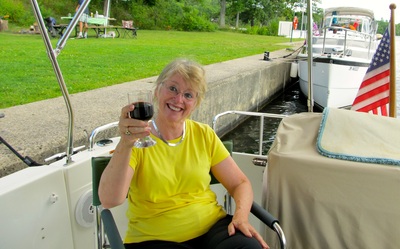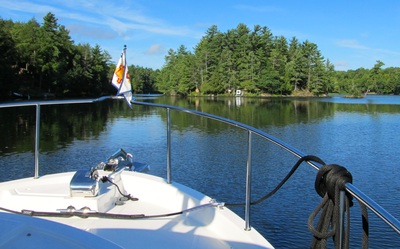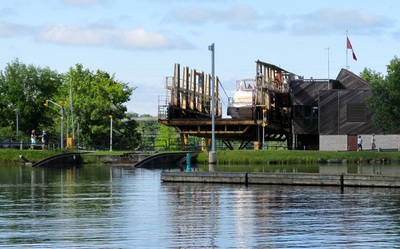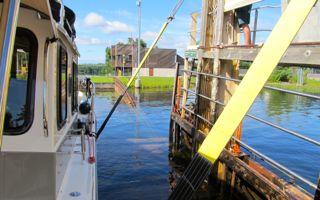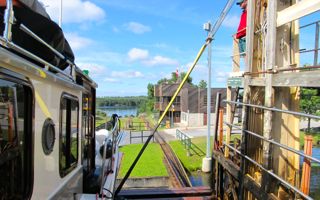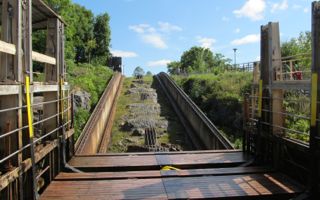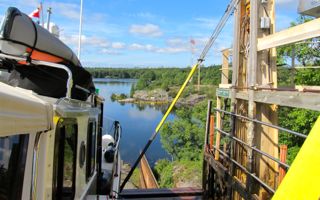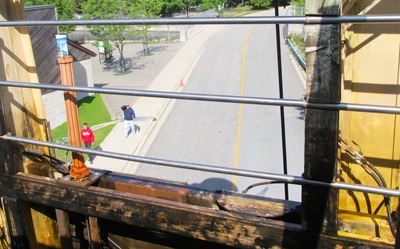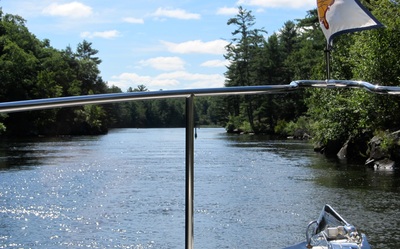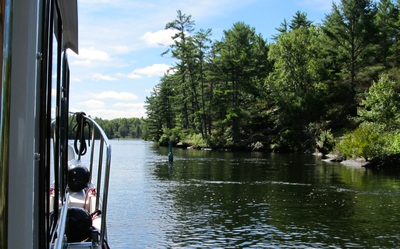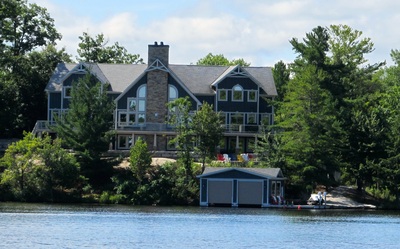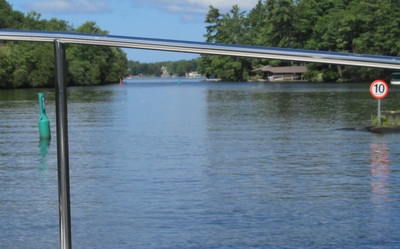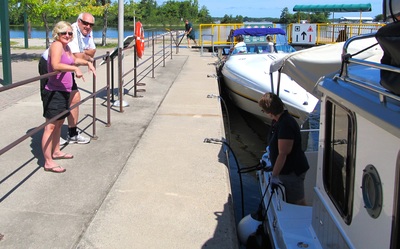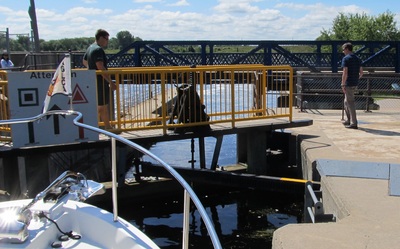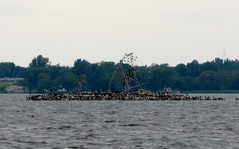FOUR DAYS IN CANADA ON THE NORTH SHORE OF ONTARIO LAKE: KINGSTON, THOUSAND ISLANDS, PICTON AND TRENTON
Sunday, July 20
Today would be another major crossing event over 50 miles of open water where the shoreline would be gone or just barely able to see. Most loopers have to wait in Oswego for the westerly winds to fade because even a minimal breeze when it runs the length of the lake, called fetch, will cause the swells to rise to several feet and these would hit the beam or side of the northbound boat causing a very uncomfortable and sometimes dangerous side to side rolling. This morning we were "Going with God" as the wind would be from the south, close to being behind Andiamo and we would ride the swells all the way to Kingston, Ontario.
Two miles after leaving Oswego, New York, the depths of the lake were in the triple digits, something that has not been experienced since Puget Sound, seven months ago. Navigation was done by the Garmin charplotter with a destination of the channel marker at Duck Island, the first land in Canada and 25 miles away and over the horizon. Andiamo was run at 3150 RPM for the next four hours, attaining 12-13 miles per hour, using 8.5 gallons per hour and with 1.5 gallons per hour. Sometimes the Garmin autopilot could not steer the following sea very well and then it would be done manually.
At the U.S and Canada border, Verizon sent texts that charges for voice and data would be substantially higher. An automated message from a vendor and no welcome message from the Canadian government? If the government is not tracking us, the global corporations are. The chit-chat channel on the marine radio was all French but not precisely the language spoken in France.
After putting Wolfe Island between the tug and the wind, the water became flat and on the way to Kingston, Andiamo dodged large fleets of one-person sailboats that were racing. Kingston brands itself as the sailing capital of Eastern Canada and there were ample sailboats to support that theme. Andiamo arrived at the McDonald Confederated Harbor at 2 PM having traveled 58 miles in 5 hours. The marina is in the center of downtown Kingston and the large park that was adjacent to the marina was buzzing with activity. Fearful that the marina would be full on a beautiful Sunday afternoon in late July, there was surprise at the many slips that were available.
Checking into customs by phone was easy and though we made a huge effort to get Laurie’s passport, the passport number was not asked for. Lots of questions were asked about alcohol, tobacco, firearms, and cash but none about the humans that were aboard. One night’s moorage was paid for and the $2 a foot was higher than expected. However, it would pay off with a strong Wi-Fi signal that would be used to the fullest.
The afternoon was spent on the treasure hunt for a map chip of this area for the Garmin chartplotter. Dennis and Julia, from the Erie Canal segment, live in Kingston and offered to drive us to the West Marine store as the distance was too long to walk and the streets were too difficult for bikes. West Marine once again was a huge disappointment. Despite being assured by phone on the previous day that the necessary chip was in stock, there were none to be found and the manager confirmed that a mistake was made. She offered to call the area’s ship stores but ended up just giving the list of stores and phone numbers when she realized that we were not going to buy anything. They get away with allowing disappointment because they are the “big dog” on the block and dominate the marine supply market. Dennis and Julia were wonderfully patient with us as no stores had the map chip of this area.
The serendipity occurred back at the tug with our neighbors who were from the area. Fun and worthwhile conversations happened with five couples. Conversations are easy to start by strangers after they read the homeport of Everett, Washington and the lines of the tug just creates comments. The neighbors made a convincing argument to explore the Thousand Islands that was only 20 miles from Kingston. Many of the islands are part of Canada’s national park system. The data was examined in the context that a plane had to be caught in Toronto in nine days. The plans were adjusted to include an expedition into the Thousand Islands.
Nothing was going to happen until good charts were obtained. The fix was a technological one: bypass the retail outlets and download the map directly from Garmin. Multiple steps had to be done, hardware had to be acquired and it was more expensive, but by mid-morning on the next day, it was all accomplished.
Sunday, July 20
Today would be another major crossing event over 50 miles of open water where the shoreline would be gone or just barely able to see. Most loopers have to wait in Oswego for the westerly winds to fade because even a minimal breeze when it runs the length of the lake, called fetch, will cause the swells to rise to several feet and these would hit the beam or side of the northbound boat causing a very uncomfortable and sometimes dangerous side to side rolling. This morning we were "Going with God" as the wind would be from the south, close to being behind Andiamo and we would ride the swells all the way to Kingston, Ontario.
Two miles after leaving Oswego, New York, the depths of the lake were in the triple digits, something that has not been experienced since Puget Sound, seven months ago. Navigation was done by the Garmin charplotter with a destination of the channel marker at Duck Island, the first land in Canada and 25 miles away and over the horizon. Andiamo was run at 3150 RPM for the next four hours, attaining 12-13 miles per hour, using 8.5 gallons per hour and with 1.5 gallons per hour. Sometimes the Garmin autopilot could not steer the following sea very well and then it would be done manually.
At the U.S and Canada border, Verizon sent texts that charges for voice and data would be substantially higher. An automated message from a vendor and no welcome message from the Canadian government? If the government is not tracking us, the global corporations are. The chit-chat channel on the marine radio was all French but not precisely the language spoken in France.
After putting Wolfe Island between the tug and the wind, the water became flat and on the way to Kingston, Andiamo dodged large fleets of one-person sailboats that were racing. Kingston brands itself as the sailing capital of Eastern Canada and there were ample sailboats to support that theme. Andiamo arrived at the McDonald Confederated Harbor at 2 PM having traveled 58 miles in 5 hours. The marina is in the center of downtown Kingston and the large park that was adjacent to the marina was buzzing with activity. Fearful that the marina would be full on a beautiful Sunday afternoon in late July, there was surprise at the many slips that were available.
Checking into customs by phone was easy and though we made a huge effort to get Laurie’s passport, the passport number was not asked for. Lots of questions were asked about alcohol, tobacco, firearms, and cash but none about the humans that were aboard. One night’s moorage was paid for and the $2 a foot was higher than expected. However, it would pay off with a strong Wi-Fi signal that would be used to the fullest.
The afternoon was spent on the treasure hunt for a map chip of this area for the Garmin chartplotter. Dennis and Julia, from the Erie Canal segment, live in Kingston and offered to drive us to the West Marine store as the distance was too long to walk and the streets were too difficult for bikes. West Marine once again was a huge disappointment. Despite being assured by phone on the previous day that the necessary chip was in stock, there were none to be found and the manager confirmed that a mistake was made. She offered to call the area’s ship stores but ended up just giving the list of stores and phone numbers when she realized that we were not going to buy anything. They get away with allowing disappointment because they are the “big dog” on the block and dominate the marine supply market. Dennis and Julia were wonderfully patient with us as no stores had the map chip of this area.
The serendipity occurred back at the tug with our neighbors who were from the area. Fun and worthwhile conversations happened with five couples. Conversations are easy to start by strangers after they read the homeport of Everett, Washington and the lines of the tug just creates comments. The neighbors made a convincing argument to explore the Thousand Islands that was only 20 miles from Kingston. Many of the islands are part of Canada’s national park system. The data was examined in the context that a plane had to be caught in Toronto in nine days. The plans were adjusted to include an expedition into the Thousand Islands.
Nothing was going to happen until good charts were obtained. The fix was a technological one: bypass the retail outlets and download the map directly from Garmin. Multiple steps had to be done, hardware had to be acquired and it was more expensive, but by mid-morning on the next day, it was all accomplished.
The next day, the morning was overcast with a fresh breeze from the south leaving no doubt that Lake Ontario had some serious swells rolling across it from Oswego. A Nordic 32 with a couple from Connecticut was heading to Oswego and would probably wish that they got an earlier start when the wind was light.
After finishing the chart download project that included a walk to Staples in a downtown that was just waking up, Andiamo headed west up the St. Lawrence River on the Bateau Channel and was immediately surrounded with islands that were lush with forest. Being in clear, fresh water makes one understand the phobia of saltwater that is heard so frequently. With passion, these boaters do not want to get their trailers wet in saltwater and a few will not consider buying a boat that has been in saltwater. These privately owned islands were extensively developed and the larger ones had many homes on very large parcels. On some of the smaller ones, the house took the entire island.
The channels were often narrow but well marked and deep. Off channel, the water was shallow and strewn with rocks. The journey was not stressful but demanded one's full attention. Running at 8 MPH, Andiamo was in the thick of the islands in two hours. Two ferries that link Howe Island to the mainland are cable ferries, meaning that engines on the ferry pull on thick steel cables that normally lay on the bottom of the channel until they are used to pull the ferry. Anchorages were explored, considered and discarded until finding the small cove on the southeast side of Leek Island that had mooring buoys available.
Two pairs of local boats were rafted together and anchored and except for the occasional boat wake from the channel, it was a quiet and protected place. After lunch, the wet suit and snorkel gear was used to inspect the bottom. More barnacles from the salt water were removed from the trim tabs but the rudder and propeller were clear. The clarity of the water was amazing and this provided the opportunity to scrap the keel. The prop zinc was gone and because the bolt was gone also, it probably unscrewed and fell off. The “license plate” anode that is bolted to the transom and is the size of a license plate needs to be replaced. Afterwards, the cove was explored with mask and snorkel and the 2/3-mill wetsuit was perfect for the 70-degree water.
The late afternoon was not too hot or breezy and the lake became flat and calm. Two sailboats arrived that were about the same size as our first sailboat. Five kids, all under 12 years old dove into the water and splashed around. Afterwards, they lounged on the foredeck with feet dangling over the side. Just like our kids did.
After finishing the chart download project that included a walk to Staples in a downtown that was just waking up, Andiamo headed west up the St. Lawrence River on the Bateau Channel and was immediately surrounded with islands that were lush with forest. Being in clear, fresh water makes one understand the phobia of saltwater that is heard so frequently. With passion, these boaters do not want to get their trailers wet in saltwater and a few will not consider buying a boat that has been in saltwater. These privately owned islands were extensively developed and the larger ones had many homes on very large parcels. On some of the smaller ones, the house took the entire island.
The channels were often narrow but well marked and deep. Off channel, the water was shallow and strewn with rocks. The journey was not stressful but demanded one's full attention. Running at 8 MPH, Andiamo was in the thick of the islands in two hours. Two ferries that link Howe Island to the mainland are cable ferries, meaning that engines on the ferry pull on thick steel cables that normally lay on the bottom of the channel until they are used to pull the ferry. Anchorages were explored, considered and discarded until finding the small cove on the southeast side of Leek Island that had mooring buoys available.
Two pairs of local boats were rafted together and anchored and except for the occasional boat wake from the channel, it was a quiet and protected place. After lunch, the wet suit and snorkel gear was used to inspect the bottom. More barnacles from the salt water were removed from the trim tabs but the rudder and propeller were clear. The clarity of the water was amazing and this provided the opportunity to scrap the keel. The prop zinc was gone and because the bolt was gone also, it probably unscrewed and fell off. The “license plate” anode that is bolted to the transom and is the size of a license plate needs to be replaced. Afterwards, the cove was explored with mask and snorkel and the 2/3-mill wetsuit was perfect for the 70-degree water.
The late afternoon was not too hot or breezy and the lake became flat and calm. Two sailboats arrived that were about the same size as our first sailboat. Five kids, all under 12 years old dove into the water and splashed around. Afterwards, they lounged on the foredeck with feet dangling over the side. Just like our kids did.
Tuesday, July 22
The mooring buoy was let go after breakfast and Andiamo idled out of the cove under overcast skies and a light wind. Not feeling the need to explore more of these islands because they are so similar to our home cruising grounds, the tug headed west and circumnavigated Howe Island. In two hours, the engine’s electrical alternator had charged the iPhones and the laptops and fully recharged the house batteries.
Time was spent on the phone to find a prop zinc but to no avail. Apparently, boats in this region do not use this style of prop zinc. The dominant boat is the 20 to 40 foot sailboat, followed by the 20 to 30 foot go-fast, gas powered cruiser. Visitors, not locals, use the trawler speed and style of boats. The driver behind these choices seems to be the depth of the winter, causing docks and boats to be removed from the water and then the subsequently short boating season.
Canada does not coddle boaters with lots of channel markers. The red and green buoys are few and the floating ones are small, probably because they are removed for the winter. Visible rocks and shoals are not marked with a buoy. The assumption is the skipper will have a reasonable amount of common sense to see these obstacles and avoid them.
While underway, it was discovered that the oil pressure was 10 PSI lower than usual at all RPM’s. This is probably associated with the fact that the oil needs to be changed very soon. It has been nearly 250 hours since Jacksonville, Florida. The fix was to run the engine slowly up to 3,300 RPM and hold it there for 20 minutes. Then, slowly bringing down the engine’s speed to the slow cruising speed revealed that the PSI was back to normal. Probably, there was gunk in the system.
Past Kingston, the urban development faded away to agriculture and forest. Up the Aldophus Reach and aside from a trio of boats, the tug was the only craft on the water.
At 3 PM, Andiamo arrived at Picton that is at the head of a long bay and is well protected. The town’s dock was full of three large yachts but the Prince Edward Yacht Club had room for a 30 foot tug. We paid $1.75 a foot and $5 for 15-amp power but if we were members of a yacht club, $25 would have covered two nights of moorage. The boaters and the club members were very friendly. A walk into town found a vibrant and busy community. After dinner, we attended an evening service at the Anglican Church and were welcomed by friendly parishioners.
Andiamo had traveled 56 miles in 7 hours.
The mooring buoy was let go after breakfast and Andiamo idled out of the cove under overcast skies and a light wind. Not feeling the need to explore more of these islands because they are so similar to our home cruising grounds, the tug headed west and circumnavigated Howe Island. In two hours, the engine’s electrical alternator had charged the iPhones and the laptops and fully recharged the house batteries.
Time was spent on the phone to find a prop zinc but to no avail. Apparently, boats in this region do not use this style of prop zinc. The dominant boat is the 20 to 40 foot sailboat, followed by the 20 to 30 foot go-fast, gas powered cruiser. Visitors, not locals, use the trawler speed and style of boats. The driver behind these choices seems to be the depth of the winter, causing docks and boats to be removed from the water and then the subsequently short boating season.
Canada does not coddle boaters with lots of channel markers. The red and green buoys are few and the floating ones are small, probably because they are removed for the winter. Visible rocks and shoals are not marked with a buoy. The assumption is the skipper will have a reasonable amount of common sense to see these obstacles and avoid them.
While underway, it was discovered that the oil pressure was 10 PSI lower than usual at all RPM’s. This is probably associated with the fact that the oil needs to be changed very soon. It has been nearly 250 hours since Jacksonville, Florida. The fix was to run the engine slowly up to 3,300 RPM and hold it there for 20 minutes. Then, slowly bringing down the engine’s speed to the slow cruising speed revealed that the PSI was back to normal. Probably, there was gunk in the system.
Past Kingston, the urban development faded away to agriculture and forest. Up the Aldophus Reach and aside from a trio of boats, the tug was the only craft on the water.
At 3 PM, Andiamo arrived at Picton that is at the head of a long bay and is well protected. The town’s dock was full of three large yachts but the Prince Edward Yacht Club had room for a 30 foot tug. We paid $1.75 a foot and $5 for 15-amp power but if we were members of a yacht club, $25 would have covered two nights of moorage. The boaters and the club members were very friendly. A walk into town found a vibrant and busy community. After dinner, we attended an evening service at the Anglican Church and were welcomed by friendly parishioners.
Andiamo had traveled 56 miles in 7 hours.
The next day, the weather forecast was for building winds in the afternoon. With Trenton being the next destination and was 40 miles away, Andiamo pulled away from the dock at 7 AM.
This part of the Great Loop has several options for routes. From the Erie Canal, boaters can continue west to the end of the canal at Buffalo, New York. There, they can head west into Lake Erie and never go into Canada. Our choice was to experience Canada’s Trent-Severn Waterway, the Georgian Bay and North Channel because this trio was consistently received high marks from loopers. The Trent-Severn Waterway or “The Trent” as the locals call it, is sort of an Intracoastal Waterway between Lake Ontario and Lake Huron. Rivers and lakes have been connected together by canals with locks for the purpose of moving timber from the interior. However, the success of the waterway was not for commercial traffic, but for recreational boaters. The Trent-Severn Waterway is 240 miles long with 44 locks and small towns along the way. Boaters can stay in marinas, tie to the canal’s walls or anchor. On the east side, at Lake Ontario, the waterway starts at Trenton.
From Kingston, the water route to Trenton is shaped like a large “Z.” At the bottom, left corner is Picton, and 40 miles later at the upper left is Trenton. The building winds and the probability of wind-caused swells never materialized. Andiamo purred along at 8 MPH for 5 hours, up Long Reach, around Foresters Island, through Telegraph Narrows, past Snake Island, past Bellville and finally winding around the channel markers that marked rocks and shoals to Trenton.
Andiamo was re-set in Trenton with fuel, water, pump-out, laundry and groceries. Everything in Canada is more expensive and this would be the single most expensive day on the trip so far. Diesel was $5.35 a gallon after the conversion from liters was done, $10 for pump-out and $1.75 a foot for dockage.
The bikes took us the 2 miles to the first lock of the Waterway to get an orientation of what to expect and to pay for the transit fee. The adventure was following a footpath that ended on an active railroad track and a fast train came minutes after we had found a way off the roadbed.
Afterwards, Laurie did the grocery and laundry run and I changed Andiamo’s oil and filter. The task is quite easy because the engine’s engineering was done right. Part 2 of the 250-hour service is to change the fuel filters and that will happen soon.
This marina had four looper boats docked and we enjoyed the company of people who we first saw in Florida and Georgia and another was met earlier on the Erie Canal. Exhausted from the long day, a nice dinner was found at a local restaurant.
This part of the Great Loop has several options for routes. From the Erie Canal, boaters can continue west to the end of the canal at Buffalo, New York. There, they can head west into Lake Erie and never go into Canada. Our choice was to experience Canada’s Trent-Severn Waterway, the Georgian Bay and North Channel because this trio was consistently received high marks from loopers. The Trent-Severn Waterway or “The Trent” as the locals call it, is sort of an Intracoastal Waterway between Lake Ontario and Lake Huron. Rivers and lakes have been connected together by canals with locks for the purpose of moving timber from the interior. However, the success of the waterway was not for commercial traffic, but for recreational boaters. The Trent-Severn Waterway is 240 miles long with 44 locks and small towns along the way. Boaters can stay in marinas, tie to the canal’s walls or anchor. On the east side, at Lake Ontario, the waterway starts at Trenton.
From Kingston, the water route to Trenton is shaped like a large “Z.” At the bottom, left corner is Picton, and 40 miles later at the upper left is Trenton. The building winds and the probability of wind-caused swells never materialized. Andiamo purred along at 8 MPH for 5 hours, up Long Reach, around Foresters Island, through Telegraph Narrows, past Snake Island, past Bellville and finally winding around the channel markers that marked rocks and shoals to Trenton.
Andiamo was re-set in Trenton with fuel, water, pump-out, laundry and groceries. Everything in Canada is more expensive and this would be the single most expensive day on the trip so far. Diesel was $5.35 a gallon after the conversion from liters was done, $10 for pump-out and $1.75 a foot for dockage.
The bikes took us the 2 miles to the first lock of the Waterway to get an orientation of what to expect and to pay for the transit fee. The adventure was following a footpath that ended on an active railroad track and a fast train came minutes after we had found a way off the roadbed.
Afterwards, Laurie did the grocery and laundry run and I changed Andiamo’s oil and filter. The task is quite easy because the engine’s engineering was done right. Part 2 of the 250-hour service is to change the fuel filters and that will happen soon.
This marina had four looper boats docked and we enjoyed the company of people who we first saw in Florida and Georgia and another was met earlier on the Erie Canal. Exhausted from the long day, a nice dinner was found at a local restaurant.
the trent-severn waterway
THREE DAYS FROM TRENTON TO PETERBOROUGH
Thursday, July 24
The morning was clear, warm and calm. Craig is the dockmaster and has worked at the marina for 16 years. His attention to detail and care for customer service clearly telegraphed that he was an owner. He communicates every morning with Brad, the lockmaster at lock number 1 with the number of boats coming his way. At the lock wall, we met two other looper boats, one that we had known from the Erie Canal, and WE would lock through 12 locks, a new personal record, with them today.
The first six locks lifted us 119 feet in just over seven miles. It was a day of slow boat maneuvering. When the lock doors open, the boats go in one at a time at idle speed. The length of these three boats would fill the length of the lock with just a few feet left over. The tug was stopped at one of the vinyl covered steel cables that were stretched from the top of the lock to the bottom. Unlike the Erie Canal, these locks required that boats attached to two cables. I would grab one from the sliding side door at the helm station and Laurie would take one at the stern. Lines are wrapped around the cable and held onto a cleat as the water rises. Sometimes there was turbulence that had to be handled. When the lock doors opened, the tug is eased away from the lock way and idled out. Most of the time, the waterway had a 6.2 MPH (10KM) speed limit.
The lockmasters ranged from being very nice and engaging to being disinterested. Several lockmasters said that the number of boaters was down from last year. The lockmaster at Lock 7 introduced us to the “Booming Metropolis of Glen Ross” that consisted of only an ice cream shop on the side of the road and made a brief sermon of how mosquitos are attracted to person by their blood type. Another lockmaster told us to look for the nearby beaver lodge and ospreys in the distance.
The topography was generally low elevation and the vegetation moved from lush groves of trees to a drier, shrubby landscape, and to marsh. Huge dairy farms were seen in the distance. More and more cottages (an English/Canadian term for small cabins and houses) were found with most flying the Canadian flag. Simply, it was splendid.
Locks 11 and 12 were a double lock of one emptying into one another. When the lock door paused for three minutes during closing, we entertained the thought of having to spend the night in the lock. The Town of Campbellford was the destination and Andiamo stayed on the town’s wall with 13 other boats, all of them were Canadians. Given a choice between visiting with strangers who may be local or with familiar boaters, we typically choose the former. The visitor center was glad to take the dockage fee and the employee said they had never seen so many boats in town. We walked, talked to boaters, and planned to visit the sights tomorrow.
Andiamo had traveled 31 miles in nearly 9 hours and the crew was tired. Of that, 4.5 hours was spent in locks.
The next day, though we had hoped to spend a half-day in Campbellford to explore the chocolate factory, the bakery and bike this small community, a look at the updated weather forecast showed that a front was approaching from the prairie states. Traveling on Saturday and early Sunday was in doubt. Laurie walked to the bakery as it opened at 7:30 AM and came back with sack of goodies, especially butter tarts, a treat that was heard about and needed to be experienced. We needed to be in Peterborough for plane flight in a few days, so Andiamo left the town wall to catch the soonest lock-through when operations started at 9AM.
We waited on the lock wall for an hour with two other boats operated by Larry and Jan and Don and Anita. These two boats would fill the lock’s length and rafting to their sides would be necessary. When lock operations started, three more boats arrived and two more were approaching. We elected to not raft to Larry/Jan and Don/Anita, a decision that would be regretted, as the next cycle of locking was an hour later. For the remainder of the day, Andiamo and three other boats would lock together, either rafting together or being independent on the lock walls. Andiamo would be buddy boating and we got to know Brian and Lynn who lived in the region.
Today’s route would include the Trent River, Seymour Lake, Birch Narrows, and too many islands to name. Cottages frequently hugged the shoreline and are owned by “Cottagers.” Probably serving the urban populations of Toronto and Ottawa, these structures ranged from family-built one story structures to the very expensive and elaborate.
Traveling on this portion of the Trent-Severn Waterway is done at the pace of the locks and the attitude has to be adjusted and the behavior adapted. In seven hours, 6 locks would be transited and only 21 miles traveled. Spending a lot of time in locks created opportunities for conversation with other boaters. At Hastings, Ontario came the realization that Andiamo was too late to get to Peterborough as lock operations cease at 6:30 PM and the opportunities to stop or anchor were very limited. The capping piece of information was that the wind had built on the 20-mile length of Rice Lake and the ride was rough and the going was slow. All the Peterborough-bound boats elected to stop after the lock in Hastings, Ontario.
Given the choice of spending perhaps two days on the lock wall or going to a nearby marina, the Hastings Village Marina was chosen. Laurie’s call on the radio was immediately answered and a slip was available. The availability of moorage on short notice is one of the benefits of the Ranger 29. In 4 minutes, Andiamo was backed into a slip and welcomed by a band of friendly boaters who spend the majority of their summer here.
Dinner was at the “Captain’s Table” that is known for its fish and chips. The sure signs of a local’s place were the salt-of-the-earth demographics where hats are worn and the waitress asks, “Do you need to see a menu?” Following her recommendation resulted in a splendid dinner of halibut and chips.
On Saturday, the weather forecast had changed with the rain and higher winds pushed backed a day or two. But the fresh breeze coming down the length of the Rice Lake was a concern. The other looper boats on the lock wall probably sensed the same opportunity and took off early and Andiamo left sooner than later. The destination was 40 miles away at Peterborough, the largest city with 80,000 people, on this part of the Trent-Severn Waterway and was a common layover port of loopers.
The travel day was delightful with the tug going 8 MPH, dropping to 6.2 MPH in the speed zones, and the water was comfortable. We were once again alone on the water as the other boats were way ahead. Rice Lake had a 1-foot chop that was on the bow but was quite comfortable. Andiamo passed the islands of Margaret, Grasshopper, East Grape, Rack, Sugar, Prison, and Spook. The regret that was felt yesterday about not getting to Peterborough was erased because that would have required cruising at the tug’s high speed. Andiamo would have used 30 gallons of diesel at over $150 and we would not have enjoyed the trip. Instead, the tug used 10 gallons of diesel or $50 and the scenery was great.
Before the reaching the end of Rice Lake, the waterway turned to starboard at the Otonabee River and the route was narrow, twisting and very scenic. Laurie identified the trees as maple, pine, willow, and birch. Fisherman were in the bends of the river, the cottages were just coming to life in the mid-morning as the temperature eased upward from the mid-70’s, and there were stretches of a feeling of being in a wilderness.
The only lock of the day came at Peterborough when we arrived at noon. This is one of the original locks that were made from limestone blocks. Afterwards, Andiamo turned into Little Lake and the Peterborough Marina. After lunch, the bikes took us to the Peterborough Lift Lock that Andiamo would go thorough when we returned from the 10-day trip to Seattle. Laurie picked up a cruising guide for the Georgian Bay and the North Channel. The Andiamo Mojo was in high gear as the tug attracted many comments and questions.
Don and Lynn were docked nearby and we enjoyed dock-tails with them. A light dinner followed and Laurie attended the free community concert with a few hundred others. In the late night hours, the thunder and lightning storm came with a brief period of drenching rain.
Thursday, July 24
The morning was clear, warm and calm. Craig is the dockmaster and has worked at the marina for 16 years. His attention to detail and care for customer service clearly telegraphed that he was an owner. He communicates every morning with Brad, the lockmaster at lock number 1 with the number of boats coming his way. At the lock wall, we met two other looper boats, one that we had known from the Erie Canal, and WE would lock through 12 locks, a new personal record, with them today.
The first six locks lifted us 119 feet in just over seven miles. It was a day of slow boat maneuvering. When the lock doors open, the boats go in one at a time at idle speed. The length of these three boats would fill the length of the lock with just a few feet left over. The tug was stopped at one of the vinyl covered steel cables that were stretched from the top of the lock to the bottom. Unlike the Erie Canal, these locks required that boats attached to two cables. I would grab one from the sliding side door at the helm station and Laurie would take one at the stern. Lines are wrapped around the cable and held onto a cleat as the water rises. Sometimes there was turbulence that had to be handled. When the lock doors opened, the tug is eased away from the lock way and idled out. Most of the time, the waterway had a 6.2 MPH (10KM) speed limit.
The lockmasters ranged from being very nice and engaging to being disinterested. Several lockmasters said that the number of boaters was down from last year. The lockmaster at Lock 7 introduced us to the “Booming Metropolis of Glen Ross” that consisted of only an ice cream shop on the side of the road and made a brief sermon of how mosquitos are attracted to person by their blood type. Another lockmaster told us to look for the nearby beaver lodge and ospreys in the distance.
The topography was generally low elevation and the vegetation moved from lush groves of trees to a drier, shrubby landscape, and to marsh. Huge dairy farms were seen in the distance. More and more cottages (an English/Canadian term for small cabins and houses) were found with most flying the Canadian flag. Simply, it was splendid.
Locks 11 and 12 were a double lock of one emptying into one another. When the lock door paused for three minutes during closing, we entertained the thought of having to spend the night in the lock. The Town of Campbellford was the destination and Andiamo stayed on the town’s wall with 13 other boats, all of them were Canadians. Given a choice between visiting with strangers who may be local or with familiar boaters, we typically choose the former. The visitor center was glad to take the dockage fee and the employee said they had never seen so many boats in town. We walked, talked to boaters, and planned to visit the sights tomorrow.
Andiamo had traveled 31 miles in nearly 9 hours and the crew was tired. Of that, 4.5 hours was spent in locks.
The next day, though we had hoped to spend a half-day in Campbellford to explore the chocolate factory, the bakery and bike this small community, a look at the updated weather forecast showed that a front was approaching from the prairie states. Traveling on Saturday and early Sunday was in doubt. Laurie walked to the bakery as it opened at 7:30 AM and came back with sack of goodies, especially butter tarts, a treat that was heard about and needed to be experienced. We needed to be in Peterborough for plane flight in a few days, so Andiamo left the town wall to catch the soonest lock-through when operations started at 9AM.
We waited on the lock wall for an hour with two other boats operated by Larry and Jan and Don and Anita. These two boats would fill the lock’s length and rafting to their sides would be necessary. When lock operations started, three more boats arrived and two more were approaching. We elected to not raft to Larry/Jan and Don/Anita, a decision that would be regretted, as the next cycle of locking was an hour later. For the remainder of the day, Andiamo and three other boats would lock together, either rafting together or being independent on the lock walls. Andiamo would be buddy boating and we got to know Brian and Lynn who lived in the region.
Today’s route would include the Trent River, Seymour Lake, Birch Narrows, and too many islands to name. Cottages frequently hugged the shoreline and are owned by “Cottagers.” Probably serving the urban populations of Toronto and Ottawa, these structures ranged from family-built one story structures to the very expensive and elaborate.
Traveling on this portion of the Trent-Severn Waterway is done at the pace of the locks and the attitude has to be adjusted and the behavior adapted. In seven hours, 6 locks would be transited and only 21 miles traveled. Spending a lot of time in locks created opportunities for conversation with other boaters. At Hastings, Ontario came the realization that Andiamo was too late to get to Peterborough as lock operations cease at 6:30 PM and the opportunities to stop or anchor were very limited. The capping piece of information was that the wind had built on the 20-mile length of Rice Lake and the ride was rough and the going was slow. All the Peterborough-bound boats elected to stop after the lock in Hastings, Ontario.
Given the choice of spending perhaps two days on the lock wall or going to a nearby marina, the Hastings Village Marina was chosen. Laurie’s call on the radio was immediately answered and a slip was available. The availability of moorage on short notice is one of the benefits of the Ranger 29. In 4 minutes, Andiamo was backed into a slip and welcomed by a band of friendly boaters who spend the majority of their summer here.
Dinner was at the “Captain’s Table” that is known for its fish and chips. The sure signs of a local’s place were the salt-of-the-earth demographics where hats are worn and the waitress asks, “Do you need to see a menu?” Following her recommendation resulted in a splendid dinner of halibut and chips.
On Saturday, the weather forecast had changed with the rain and higher winds pushed backed a day or two. But the fresh breeze coming down the length of the Rice Lake was a concern. The other looper boats on the lock wall probably sensed the same opportunity and took off early and Andiamo left sooner than later. The destination was 40 miles away at Peterborough, the largest city with 80,000 people, on this part of the Trent-Severn Waterway and was a common layover port of loopers.
The travel day was delightful with the tug going 8 MPH, dropping to 6.2 MPH in the speed zones, and the water was comfortable. We were once again alone on the water as the other boats were way ahead. Rice Lake had a 1-foot chop that was on the bow but was quite comfortable. Andiamo passed the islands of Margaret, Grasshopper, East Grape, Rack, Sugar, Prison, and Spook. The regret that was felt yesterday about not getting to Peterborough was erased because that would have required cruising at the tug’s high speed. Andiamo would have used 30 gallons of diesel at over $150 and we would not have enjoyed the trip. Instead, the tug used 10 gallons of diesel or $50 and the scenery was great.
Before the reaching the end of Rice Lake, the waterway turned to starboard at the Otonabee River and the route was narrow, twisting and very scenic. Laurie identified the trees as maple, pine, willow, and birch. Fisherman were in the bends of the river, the cottages were just coming to life in the mid-morning as the temperature eased upward from the mid-70’s, and there were stretches of a feeling of being in a wilderness.
The only lock of the day came at Peterborough when we arrived at noon. This is one of the original locks that were made from limestone blocks. Afterwards, Andiamo turned into Little Lake and the Peterborough Marina. After lunch, the bikes took us to the Peterborough Lift Lock that Andiamo would go thorough when we returned from the 10-day trip to Seattle. Laurie picked up a cruising guide for the Georgian Bay and the North Channel. The Andiamo Mojo was in high gear as the tug attracted many comments and questions.
Don and Lynn were docked nearby and we enjoyed dock-tails with them. A light dinner followed and Laurie attended the free community concert with a few hundred others. In the late night hours, the thunder and lightning storm came with a brief period of drenching rain.
Sunday & Monday, July 27 and 28,
These two days in Peterborough were spent seeing the area, doing boat projects, and prepping for the trip back to Seattle. We walked to the Sunday morning service at All Saints Anglican Church, a big beautiful building that could seat 250 people and was attended by about 75 people who were all over the age of 70. They were warm and friendly, the rector’s sermon was compelling and the message was well received.
The bikes took us the Peterborough Canoe Museum, which told the story of the First Nations and the history of fur trade that was centered on the canoe. The museum had a great collection of different canoes and kayaks made over time. One take-away was the canoe used by the Hudson Bay Company to move freight throughout the waterways in Canada was 36 feet long and could move 8 tons of goods. The paddlers consumed 5,000 calories a day and could portage 180 pounds of goods in jog/trot. After an afternoon of boat projects and conversations with people who were attracted to Andiamo, dock-tails were enjoyed with the loopers Anita/Don, Pauline/Mark, and Larry/Jan.
The rain came earlier and harder during the night than was forecasted and the north wind stayed throughout the following day. All the locals said that this weather was very unusual for this time of year. Enterprise Car Rental picked us up at the marina and Laurie did a store run with other loopers. I changed the fuel filters, which is a straightforward project unless a gasket does not seat properly causing a fair amount of diesel to be dumped into the bilge. The remainder of the afternoon was fixing the issue and cleaning up the ramifications.
The wind faded in the late afternoon and the loopers were planning their exit. Perhaps we will see them again on the inland river system.
We fly out of Toronto tomorrow and will return to the tug on August 10.
These two days in Peterborough were spent seeing the area, doing boat projects, and prepping for the trip back to Seattle. We walked to the Sunday morning service at All Saints Anglican Church, a big beautiful building that could seat 250 people and was attended by about 75 people who were all over the age of 70. They were warm and friendly, the rector’s sermon was compelling and the message was well received.
The bikes took us the Peterborough Canoe Museum, which told the story of the First Nations and the history of fur trade that was centered on the canoe. The museum had a great collection of different canoes and kayaks made over time. One take-away was the canoe used by the Hudson Bay Company to move freight throughout the waterways in Canada was 36 feet long and could move 8 tons of goods. The paddlers consumed 5,000 calories a day and could portage 180 pounds of goods in jog/trot. After an afternoon of boat projects and conversations with people who were attracted to Andiamo, dock-tails were enjoyed with the loopers Anita/Don, Pauline/Mark, and Larry/Jan.
The rain came earlier and harder during the night than was forecasted and the north wind stayed throughout the following day. All the locals said that this weather was very unusual for this time of year. Enterprise Car Rental picked us up at the marina and Laurie did a store run with other loopers. I changed the fuel filters, which is a straightforward project unless a gasket does not seat properly causing a fair amount of diesel to be dumped into the bilge. The remainder of the afternoon was fixing the issue and cleaning up the ramifications.
The wind faded in the late afternoon and the loopers were planning their exit. Perhaps we will see them again on the inland river system.
We fly out of Toronto tomorrow and will return to the tug on August 10.
Monday, August 11
Andiamo greeted us in the mid-afternoon after the red-eye flight and the car rental from Toronto. We had 10 days in beautiful Seattle for a graduation and a birthday plus visits with friends. Taking care of relationships and being present can be in opposition to do the loop. All was well with the tug and it was good to return to the trip. We are probably the last of the loopers as the flock is heading down Lake Michigan intent on being through Chicago no later than Labor Day. Being at the end of the traditional weather window does play on our minds. However, we will not rush the trip and will take advantage of the opportunities that are presented.
Laurie spent the afternoon doing a provisioning run while I re-set the systems, packed, and did a cleaning. We crashed early and missed most of the rain, wind and thunderstorm that swept over the marina in the early morning hours.
Andiamo greeted us in the mid-afternoon after the red-eye flight and the car rental from Toronto. We had 10 days in beautiful Seattle for a graduation and a birthday plus visits with friends. Taking care of relationships and being present can be in opposition to do the loop. All was well with the tug and it was good to return to the trip. We are probably the last of the loopers as the flock is heading down Lake Michigan intent on being through Chicago no later than Labor Day. Being at the end of the traditional weather window does play on our minds. However, we will not rush the trip and will take advantage of the opportunities that are presented.
Laurie spent the afternoon doing a provisioning run while I re-set the systems, packed, and did a cleaning. We crashed early and missed most of the rain, wind and thunderstorm that swept over the marina in the early morning hours.
5 days from Peterborough to Orillia, Ontario
Tuesday, August 12
The morning rain cleared off by 9AM leaving a solid cloud cover and a steady south wind that would stay the whole day. After breakfast, the rental car was returned while the laundry was done. Ross, the driver from Enterprise said that he knew of Andiamo at the marina and had taken photos of it. He talked of the places to see in the coming days and how nice the coming part of the Trent-Severn would be.
The weather outlook was acceptable for travel during the afternoon and the south wind would be behind Andiamo for most of the day and therefore would have little impact. We had a date to pickup my sister Peggy in Lindsay, Ontario in two days and we wanted to enjoy the trip. The day’s destinations would be either Lakefield or Young’s Point. Ross said that Lakefield is only 8 miles and a 20-minute drive from Peterborough but would take 4 hours by boat if the tug had to wait at the locks.
The south wind was in the mid-teens and gusting to the low 30’s as the tug eased out of its slip with the shallow water alarm going off momentarily. Ben, the marina employee, did the pump-out for us and said he had not seen any looper boats for over a week. He said September’s weather could create some nasty water on the Great Lakes. He spends his summers working at the marina, snowboards and works at the city’s hockey rink in the winter. He is dreaming to crew on passage maker boats that are going from Florida to Europe. Ben called the lockmaster at Lock 20 to tell them of our coming.
The doors of Lock 20 were closed so Andiamo was tied up to the “blue line” wall that designates a boat is waiting to use the lock and I walked up to the lock. The very nice young woman told me to tie up to the starboard side of the lock and as far back as possible to minimize the turbulence from the incoming water. After Andiamo was locked through, another lock employee rode a bike to the nearby highway swing bridge to lower the gates and open the bridge for Andiamo.
The next lock was the renowned and impressive Peterborough Lift Lock and there are only 8 of them in the world; two of those are on the Trent-Severn Waterway. Simply, Andiamo glided into a huge bathtub and it was lifted 65 feet to the canal. The lifting was done when an identical huge bathtub, that was above us, dropped and the whole lifting took 90 seconds, using only gravity and valves. Being on the lift lock was quiet and surreal because suddenly there was dry land under the bathtub that carried Andiamo. Cars had stopped on the roads and people came out to see the sight of Andiamo being lifted.
Above Peterborough, the waterway was cut into limestone and the channel was only 40 feet wide and heavily overgrown until it opened up a Trent University and its cluster of ugly concrete buildings that dominated the architecture of the 1970’s. It resembled a medieval monastery.
Through the afternoon, Andiamo transited seven more locks and was the only boat. The lock staff had communicated with each other and the locks were generally open and ready for our arrival. Between locks, the speed limit was typically 10 km or 6.2 MPH. Two Parks Canada employees typically staff the locks and most were a male-female team. Except for the last lock of the day, these were all operated by hand cranks. After the tug was tied up, the rear lock doors are cranked closed. The lock doors are wood, heavy beams stacked on top of each other and in a wood frame that is supported by steel. There are no gaskets between the doors; the small gap between the doors is gone when the pressure from the incoming water pushes the doors to make a watertight seal.
On top of the closed doors, the staff hand cranks closed small openings in the bottom of the doors and this seals the chamber. On the front doors, the staff opens the small openings and water rushes into the chamber. Then the chamber is full and the pressure is relieved on the front door, the doors are cranked opened.
After Lakefield, we continued on to Young’s Point by traveling the length of the Katchewanooka (probably pronounced catch-ee-wan-ooka) Lake. Is the lake named after the fish that is caught or is what the man caught for messing around with the local talent? The first rental houseboats were seen at Lakefield and these would become more prevalent later. These locks were converted to hydraulic power because of the frequency of use.
The day was concluded by mooring to the lock wall on the upside of the Young’s Point Lock, number 27. Ice cream was enjoyed at the Lockside General Store and three local women out for a walk came by because they had a case of Andiamo Mojo. One loved the winters here because of the snowmobiling opportunities, one would rather be in Florida and the other loved the winters in Hawaii. Ham, new potatoes and veggies were served with wine.
Andiamo had traveled for 5 hours, ran the engine for 3 and covered 16 miles
The morning rain cleared off by 9AM leaving a solid cloud cover and a steady south wind that would stay the whole day. After breakfast, the rental car was returned while the laundry was done. Ross, the driver from Enterprise said that he knew of Andiamo at the marina and had taken photos of it. He talked of the places to see in the coming days and how nice the coming part of the Trent-Severn would be.
The weather outlook was acceptable for travel during the afternoon and the south wind would be behind Andiamo for most of the day and therefore would have little impact. We had a date to pickup my sister Peggy in Lindsay, Ontario in two days and we wanted to enjoy the trip. The day’s destinations would be either Lakefield or Young’s Point. Ross said that Lakefield is only 8 miles and a 20-minute drive from Peterborough but would take 4 hours by boat if the tug had to wait at the locks.
The south wind was in the mid-teens and gusting to the low 30’s as the tug eased out of its slip with the shallow water alarm going off momentarily. Ben, the marina employee, did the pump-out for us and said he had not seen any looper boats for over a week. He said September’s weather could create some nasty water on the Great Lakes. He spends his summers working at the marina, snowboards and works at the city’s hockey rink in the winter. He is dreaming to crew on passage maker boats that are going from Florida to Europe. Ben called the lockmaster at Lock 20 to tell them of our coming.
The doors of Lock 20 were closed so Andiamo was tied up to the “blue line” wall that designates a boat is waiting to use the lock and I walked up to the lock. The very nice young woman told me to tie up to the starboard side of the lock and as far back as possible to minimize the turbulence from the incoming water. After Andiamo was locked through, another lock employee rode a bike to the nearby highway swing bridge to lower the gates and open the bridge for Andiamo.
The next lock was the renowned and impressive Peterborough Lift Lock and there are only 8 of them in the world; two of those are on the Trent-Severn Waterway. Simply, Andiamo glided into a huge bathtub and it was lifted 65 feet to the canal. The lifting was done when an identical huge bathtub, that was above us, dropped and the whole lifting took 90 seconds, using only gravity and valves. Being on the lift lock was quiet and surreal because suddenly there was dry land under the bathtub that carried Andiamo. Cars had stopped on the roads and people came out to see the sight of Andiamo being lifted.
Above Peterborough, the waterway was cut into limestone and the channel was only 40 feet wide and heavily overgrown until it opened up a Trent University and its cluster of ugly concrete buildings that dominated the architecture of the 1970’s. It resembled a medieval monastery.
Through the afternoon, Andiamo transited seven more locks and was the only boat. The lock staff had communicated with each other and the locks were generally open and ready for our arrival. Between locks, the speed limit was typically 10 km or 6.2 MPH. Two Parks Canada employees typically staff the locks and most were a male-female team. Except for the last lock of the day, these were all operated by hand cranks. After the tug was tied up, the rear lock doors are cranked closed. The lock doors are wood, heavy beams stacked on top of each other and in a wood frame that is supported by steel. There are no gaskets between the doors; the small gap between the doors is gone when the pressure from the incoming water pushes the doors to make a watertight seal.
On top of the closed doors, the staff hand cranks closed small openings in the bottom of the doors and this seals the chamber. On the front doors, the staff opens the small openings and water rushes into the chamber. Then the chamber is full and the pressure is relieved on the front door, the doors are cranked opened.
After Lakefield, we continued on to Young’s Point by traveling the length of the Katchewanooka (probably pronounced catch-ee-wan-ooka) Lake. Is the lake named after the fish that is caught or is what the man caught for messing around with the local talent? The first rental houseboats were seen at Lakefield and these would become more prevalent later. These locks were converted to hydraulic power because of the frequency of use.
The day was concluded by mooring to the lock wall on the upside of the Young’s Point Lock, number 27. Ice cream was enjoyed at the Lockside General Store and three local women out for a walk came by because they had a case of Andiamo Mojo. One loved the winters here because of the snowmobiling opportunities, one would rather be in Florida and the other loved the winters in Hawaii. Ham, new potatoes and veggies were served with wine.
Andiamo had traveled for 5 hours, ran the engine for 3 and covered 16 miles
Wednesday, August 13
The day started with a fresh breeze, rain and total cloud cover. Summer had left this area of the Kawartha Lakes Region for the time being. Andiamo pulled away from the lock wall at 8:30 AM and headed north on Clear Lake and then turned to the west through Hell’s Gate and Devil’s Elbow which is a slalom course between huge granite boulders but the passage was safe and easy because the channel was very well marked. St. Peter's Anglican Church was built on one of these rocks and is open to boaters on Sunday.
Andiamo continued through the light rain to pass Burleigh Falls and make the right angle turn to enter the lock at Burleigh Falls. One of the reference points in the guidebooks is a “cottage” that was shaped like a cube, of glass and metal. The boat traffic on this part of the waterway had been stopped yesterday when power was lost to this lock. The boat traffic was very light probably because the wind had intensified to a sustained 15 knots with gusts to the mid-20’s. So, Andiamo was the only boat in the locks.
The tug entered Lovesick Lake where the origins of the name are in question but the theme is of a lost love. Andiamo was delayed at this lock while the lock staff did maintenance on the nearby dam. A couple that was new to boating in their go-fast cruiser joined us in the lock and would follow us for part of the day. Laurie gave advice and encouragement to the woman who was grateful. At Deer Bay, the wide width of the lake allowed the moderate wind to turn the lake into foam. But behind islands, narrower channels and in the locks, the water was calmer.
The tug continued through Lower Buckhorn Lake and stopped for lunch at Buckhorn Lock where the houseboats were the thickest we had seen. Most of the houseboat drivers are apparently new to boating and believe if a little power is effective, then more power is better. Seeing houseboats go sideways, bump into each other and hit the lock walls was a common sight. Houseboat operators help each other while boaters try to stay as far away as possible.
Buckhorn Lake and Pigeon Lake were scenic with its remoteness and beautiful cottages but the wind had risen causing a 1 to 2 foot chop on the bow. The speed of the tug was not affected by the sea conditions and spray would often hit the windows. This was the advantage of being behind windows and under a solid roof versus canvas and plastic; we were dry, warm and comfortable.
On Pigeon Lake, Andiamo plowed through the chop to the far western shore before turning north and taking the wind on its beam because the chop was minimal and the ride was comfortable. We turned to the west to enter the narrow channel that leads to the town of Bobcaygeon (pronounced Bob Cajun). We had four options to stay the night: two were staying on the lock wall and two involved marinas. The channel to the lock was choked with boats but Andiamo found the last spot on the lock wall.
Andiamo had traveled 33 miles in 6.5 hours.
My sister Peggy was arriving in Toronto tomorrow and finding transportation to Bobcaygeon was proving difficult because the rental car companies were sold out, the only bus would not bring her until the early evening and limo service was very expensive. While Laurie shopped the shoe sale at the well-known Bigley’s Shoe and Clothing Store, I had another encounter with serendipity when I met Hugh who was another bored-looking husband in a store full of shopping females. That conversation led to an offer by Hugh and his wife Karen to take us to Toronto, pickup Peggy and return us to Bobcaygeon. This is Canadian Hospitality and we would see it again. We enjoyed their company over wine in the tug.
Later, we had a light dinner and watched a movie on the tug’s TV and DVD system.
The day started with a fresh breeze, rain and total cloud cover. Summer had left this area of the Kawartha Lakes Region for the time being. Andiamo pulled away from the lock wall at 8:30 AM and headed north on Clear Lake and then turned to the west through Hell’s Gate and Devil’s Elbow which is a slalom course between huge granite boulders but the passage was safe and easy because the channel was very well marked. St. Peter's Anglican Church was built on one of these rocks and is open to boaters on Sunday.
Andiamo continued through the light rain to pass Burleigh Falls and make the right angle turn to enter the lock at Burleigh Falls. One of the reference points in the guidebooks is a “cottage” that was shaped like a cube, of glass and metal. The boat traffic on this part of the waterway had been stopped yesterday when power was lost to this lock. The boat traffic was very light probably because the wind had intensified to a sustained 15 knots with gusts to the mid-20’s. So, Andiamo was the only boat in the locks.
The tug entered Lovesick Lake where the origins of the name are in question but the theme is of a lost love. Andiamo was delayed at this lock while the lock staff did maintenance on the nearby dam. A couple that was new to boating in their go-fast cruiser joined us in the lock and would follow us for part of the day. Laurie gave advice and encouragement to the woman who was grateful. At Deer Bay, the wide width of the lake allowed the moderate wind to turn the lake into foam. But behind islands, narrower channels and in the locks, the water was calmer.
The tug continued through Lower Buckhorn Lake and stopped for lunch at Buckhorn Lock where the houseboats were the thickest we had seen. Most of the houseboat drivers are apparently new to boating and believe if a little power is effective, then more power is better. Seeing houseboats go sideways, bump into each other and hit the lock walls was a common sight. Houseboat operators help each other while boaters try to stay as far away as possible.
Buckhorn Lake and Pigeon Lake were scenic with its remoteness and beautiful cottages but the wind had risen causing a 1 to 2 foot chop on the bow. The speed of the tug was not affected by the sea conditions and spray would often hit the windows. This was the advantage of being behind windows and under a solid roof versus canvas and plastic; we were dry, warm and comfortable.
On Pigeon Lake, Andiamo plowed through the chop to the far western shore before turning north and taking the wind on its beam because the chop was minimal and the ride was comfortable. We turned to the west to enter the narrow channel that leads to the town of Bobcaygeon (pronounced Bob Cajun). We had four options to stay the night: two were staying on the lock wall and two involved marinas. The channel to the lock was choked with boats but Andiamo found the last spot on the lock wall.
Andiamo had traveled 33 miles in 6.5 hours.
My sister Peggy was arriving in Toronto tomorrow and finding transportation to Bobcaygeon was proving difficult because the rental car companies were sold out, the only bus would not bring her until the early evening and limo service was very expensive. While Laurie shopped the shoe sale at the well-known Bigley’s Shoe and Clothing Store, I had another encounter with serendipity when I met Hugh who was another bored-looking husband in a store full of shopping females. That conversation led to an offer by Hugh and his wife Karen to take us to Toronto, pickup Peggy and return us to Bobcaygeon. This is Canadian Hospitality and we would see it again. We enjoyed their company over wine in the tug.
Later, we had a light dinner and watched a movie on the tug’s TV and DVD system.
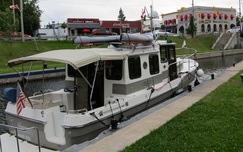
Thursday, August 14
The morning was cold, cloudy and breezy that provided a preview of what fall would be. With the interior temperature in the high 50’s, the cabin heater was turned on for the first time in 4 months. Peggy would be arriving, so the bikes were moved up to the roof and under the kayaks making the mid-cabin berth empty and available.
Hugh and Karen arrived and took us to the Toronto airport and provided an interesting narrative of their lives, living in Canada and the issues of the day. Their kindness and graciousness was over whelming. Peg was waiting on the curb. Then, Hugh took a round about route through Toronto show off the downtown with its high-rise residential complexes and vibrant economy. We received a good initial indoctrination to Canada by having coffee at a Tim Horton’s and having lunch at a Swiss Chalet. Both are widely distributed throughout Canada. Back at the tug in the mid-afternoon, we said our good-byes to Hugh and Karen.
We had made a connection to Brian and Lynn whom we had met two weeks earlier in the locks before Peterborough and they invited us for cocktails and dinner. They have a wonderful “cottage” on Lake Sturgeon that is about 15 minutes from Bobcaygeon. The conversation and their hospitality were wonderful. Brian provided information about the coming sights and ideas on how to do the remainder of the waterway. Being with them was a blessing of serendipity. Then, they took us to a Chinese restaurant for a great meal.
The morning was cold, cloudy and breezy that provided a preview of what fall would be. With the interior temperature in the high 50’s, the cabin heater was turned on for the first time in 4 months. Peggy would be arriving, so the bikes were moved up to the roof and under the kayaks making the mid-cabin berth empty and available.
Hugh and Karen arrived and took us to the Toronto airport and provided an interesting narrative of their lives, living in Canada and the issues of the day. Their kindness and graciousness was over whelming. Peg was waiting on the curb. Then, Hugh took a round about route through Toronto show off the downtown with its high-rise residential complexes and vibrant economy. We received a good initial indoctrination to Canada by having coffee at a Tim Horton’s and having lunch at a Swiss Chalet. Both are widely distributed throughout Canada. Back at the tug in the mid-afternoon, we said our good-byes to Hugh and Karen.
We had made a connection to Brian and Lynn whom we had met two weeks earlier in the locks before Peterborough and they invited us for cocktails and dinner. They have a wonderful “cottage” on Lake Sturgeon that is about 15 minutes from Bobcaygeon. The conversation and their hospitality were wonderful. Brian provided information about the coming sights and ideas on how to do the remainder of the waterway. Being with them was a blessing of serendipity. Then, they took us to a Chinese restaurant for a great meal.
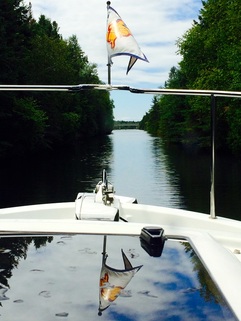
Friday, August 15
The day looked like it came from Seattle’s early November calendar with clouds, cool and the threat of rain. The diesel cabin heater was needed to make the cabin more comfortable. A walk up to the lock staff was done to tell them that Andiamo was ready when they were and the 20 something blonde female was very perky and friendly. After clearing the lock and the line of houseboats that were moored to the lock wall, Sturgeon Lake was cruised at the tug’s fast speed for the first time in weeks. The 15 miles went by in about an hour and the tug idled into the lock at Fenelon Falls where ice cream was sampled while the water tank filled.
Whitecaps caused by the rising breeze were forming on Cameron Lake and this would keep the houseboats moored to the lock walls for the day. The lakes were becoming shallower and with more weeds as Andiamo continued to climb the locks. The tug would lock into Lake Balsam and follow a narrow channel into Mitchell Lake that resembled a high mountain lake at over 800 feet above sea level. This was the height of the Trent-Severn Waterway and all westward locking would be going downstream or being lowered in the locks.
Then, like appearing out of the wilderness was the second lift lock, the Kirkfield Lift Lock, where Andiamo would be lowered nearly 49 feet in a quiet and serene drop into the forest. The waterway continued to narrow and curve with the forest lining the edges. A full size cruiser came at us and Andiamo idled down and was nudged closer to the limestone layers that jutted into the canal like knife blades that could do serious damage to the gelcoat and fiberglass.
The chartplotter showed a vessel that had AIS and it was a Ranger 25, Santolina, which we had seen at the Florida rendezvous in February. A conversation on the VHF radio revealed that they had attended the rendezvous in the Georgian Bay and were now exploring the Trent Severn before returning to Texas.
The destination was the Portage Lock, one of five locks in a close series that was near Lake Simcoe. The lock was surrounded by farms and the setting was quiet and idyllic. Andiamo was tied next to a de-masted sailboat from Michigan. Their crew reported being frustrated by the shallow water of the Trent because their five foot draft was frequently hitting bottom.
A fresh breeze from the west was coming through the trees and the crew of an eastbound powerboat reported that Lake Simcoe had five-foot high waves. Lake Simcoe could be an obstacle if the weather was up. The forecast painted a travel window in the morning that would close in the afternoon.
Chicken was BBQ and served with a fresh salad. The tug had traveled 41 miles in 6 hours of motoring.
The day looked like it came from Seattle’s early November calendar with clouds, cool and the threat of rain. The diesel cabin heater was needed to make the cabin more comfortable. A walk up to the lock staff was done to tell them that Andiamo was ready when they were and the 20 something blonde female was very perky and friendly. After clearing the lock and the line of houseboats that were moored to the lock wall, Sturgeon Lake was cruised at the tug’s fast speed for the first time in weeks. The 15 miles went by in about an hour and the tug idled into the lock at Fenelon Falls where ice cream was sampled while the water tank filled.
Whitecaps caused by the rising breeze were forming on Cameron Lake and this would keep the houseboats moored to the lock walls for the day. The lakes were becoming shallower and with more weeds as Andiamo continued to climb the locks. The tug would lock into Lake Balsam and follow a narrow channel into Mitchell Lake that resembled a high mountain lake at over 800 feet above sea level. This was the height of the Trent-Severn Waterway and all westward locking would be going downstream or being lowered in the locks.
Then, like appearing out of the wilderness was the second lift lock, the Kirkfield Lift Lock, where Andiamo would be lowered nearly 49 feet in a quiet and serene drop into the forest. The waterway continued to narrow and curve with the forest lining the edges. A full size cruiser came at us and Andiamo idled down and was nudged closer to the limestone layers that jutted into the canal like knife blades that could do serious damage to the gelcoat and fiberglass.
The chartplotter showed a vessel that had AIS and it was a Ranger 25, Santolina, which we had seen at the Florida rendezvous in February. A conversation on the VHF radio revealed that they had attended the rendezvous in the Georgian Bay and were now exploring the Trent Severn before returning to Texas.
The destination was the Portage Lock, one of five locks in a close series that was near Lake Simcoe. The lock was surrounded by farms and the setting was quiet and idyllic. Andiamo was tied next to a de-masted sailboat from Michigan. Their crew reported being frustrated by the shallow water of the Trent because their five foot draft was frequently hitting bottom.
A fresh breeze from the west was coming through the trees and the crew of an eastbound powerboat reported that Lake Simcoe had five-foot high waves. Lake Simcoe could be an obstacle if the weather was up. The forecast painted a travel window in the morning that would close in the afternoon.
Chicken was BBQ and served with a fresh salad. The tug had traveled 41 miles in 6 hours of motoring.
Saturday, August 16
Another Seattle fall-like day with drizzle that required jackets. The notion was to get an early start and the five remaining locks before Lake Simcoe were cooperative that allowed Andiamo to be on the lake in an hour. The updated weather forecast heard on the radio was coming rain and building wind in the morning. The travel window was closing soon. The lock staff reported that though they did not know the lake’s current condition, “the ride will be bouncy, but you will get through it.” Both the forecast and the lock staff would be right. The rain-ex applied to the front windows on this day would be sorely needed in two hours.
After clearing the last lock, the swing bridge, and the protected refuge, the white caps were forming across the lake. The waves were immediately one to two feet with an occasional three footer. Andiamo was taking these on the bow and then on the port quarter as the tug was turned to starboard. After the lee of Thorah Island, the waves were three to four feet with an occasional five footer. Spray was hitting the windows and occasionally going over the cabin. Andiamo was cruising at 11 miles per hour until a rogue wave hit the beam and sent all the contents on the horizontal surfaces spilling on the floor. The tug was throttled back, taken off auto pilot, and manually quartered through the waves in a zig-zag pattern that was longer and slower but slower and safer. The destination was 15 miles away and The Narrows at the northwest corner of the lake The final leg to The Narrows was with the waves on the tug’s stern, a following sea with the wind pushing the tug along at 10 miles per hour.
A pump-out was done at the first fuel dock as these facilities are scarce. $28 was the highest price we had ever paid. Under the bridge and through the narrow channel, Andiamo was in Lake Couchiching that was flat and calm but with the first significant current experienced on the Waterway. The overnight destination was the large Orillla city marina. Laurie had called ahead and they had plenty of room on a rainy and windy Saturday. Within a couple of hours of tying up, the rain intensified and the thunder and lightning storm rumbled through. Dinner was out on the town.
Andiamo had traveled 23 miles but it felt like 60.
Another Seattle fall-like day with drizzle that required jackets. The notion was to get an early start and the five remaining locks before Lake Simcoe were cooperative that allowed Andiamo to be on the lake in an hour. The updated weather forecast heard on the radio was coming rain and building wind in the morning. The travel window was closing soon. The lock staff reported that though they did not know the lake’s current condition, “the ride will be bouncy, but you will get through it.” Both the forecast and the lock staff would be right. The rain-ex applied to the front windows on this day would be sorely needed in two hours.
After clearing the last lock, the swing bridge, and the protected refuge, the white caps were forming across the lake. The waves were immediately one to two feet with an occasional three footer. Andiamo was taking these on the bow and then on the port quarter as the tug was turned to starboard. After the lee of Thorah Island, the waves were three to four feet with an occasional five footer. Spray was hitting the windows and occasionally going over the cabin. Andiamo was cruising at 11 miles per hour until a rogue wave hit the beam and sent all the contents on the horizontal surfaces spilling on the floor. The tug was throttled back, taken off auto pilot, and manually quartered through the waves in a zig-zag pattern that was longer and slower but slower and safer. The destination was 15 miles away and The Narrows at the northwest corner of the lake The final leg to The Narrows was with the waves on the tug’s stern, a following sea with the wind pushing the tug along at 10 miles per hour.
A pump-out was done at the first fuel dock as these facilities are scarce. $28 was the highest price we had ever paid. Under the bridge and through the narrow channel, Andiamo was in Lake Couchiching that was flat and calm but with the first significant current experienced on the Waterway. The overnight destination was the large Orillla city marina. Laurie had called ahead and they had plenty of room on a rainy and windy Saturday. Within a couple of hours of tying up, the rain intensified and the thunder and lightning storm rumbled through. Dinner was out on the town.
Andiamo had traveled 23 miles but it felt like 60.
Two Days from Orillia to Midland, Ontario
Sunday, August 17
Summer started to come back today with partly sunny skies and high’s in the mid-70’s. The rain that had a 30% of coming in the mid-afternoon never made it. We got up late, moved slow, and were indecisive. All of which were acceptable for a Sunday morning. Orillia was alive with activity with a triathlon and a local boater said that was an activity every weekend at the marina. Laurie and Peggy went to look for a bakery. I cleaned the interior and did the engine checks. We elected to take advantage of the nice weather and do a slow travel day, leaving just before noon, with the lock wall at Swift Rapids Lock as the destination.
The lake was flat and calm as Andiamo cruised past Chief’s Island and headed to the far eastern end where the pairs of channel markers kept us off the rocks as the waterway narrowed and turned north, under bridges and the trees came down to the shoreline. Lock 42 was our first taste of summer weekend traffic because when the gates opened, a mass of small go-fast boats came out. The eastbound boat traffic was likely homeward from playing. We easily did the 21-foot drop with another boat and when the gates opened, there were eight eastbound boats waiting to go through.
The cottages that lined this part of the remote Trent Severn Waterway were mostly modest and older but typically well maintained. The channel was sometimes narrow with 10 km/hour speed limits and opened up at Sparrow Lake and then necked down again at Sparrow Chute and through McDonald’s Cut. It felt like boating in the mountains.
Andiamo arrived at the Swift Rapids Lock in the mid-afternoon. The Swift Rapids Lock is so remote that the lock staff arrives by boat. This lock will drop us 47 feet tomorrow. We found the last place on the lock wall to moor, which was fitting, as this would probably be our last night on the Trent-Severn. Andiamo had traveled 27 miles in four hours and the cruising was easy and delightful.
We spent part of the afternoon just watching the crowds of eastbound boats trying to navigate the locks and tie up. No lines, no boat hooks, no plan and marginal skills can make a very entertaining combination for the un-involved observer.
Two Kadey-Krogen 39’s were on the wall, flying looper flags, and they would be today’s serendipity. Doug and Jan, Gary and Jacque are buddy boating in nearly identical boats and are doing the loop in a clockwise direction. They are experienced Great Lakes boaters and everything past the Georgian Bay was new. We swapped information and they were especially helpful about the Georgian Bay and the east coast of Lake Michigan by providing charts and guides. Their gift of a resource that they do not need, that we will use, is a model and tradition that we will pay forward when the opportunity presents it. Our comfort level with this coming part of the trip is forming.
Summer started to come back today with partly sunny skies and high’s in the mid-70’s. The rain that had a 30% of coming in the mid-afternoon never made it. We got up late, moved slow, and were indecisive. All of which were acceptable for a Sunday morning. Orillia was alive with activity with a triathlon and a local boater said that was an activity every weekend at the marina. Laurie and Peggy went to look for a bakery. I cleaned the interior and did the engine checks. We elected to take advantage of the nice weather and do a slow travel day, leaving just before noon, with the lock wall at Swift Rapids Lock as the destination.
The lake was flat and calm as Andiamo cruised past Chief’s Island and headed to the far eastern end where the pairs of channel markers kept us off the rocks as the waterway narrowed and turned north, under bridges and the trees came down to the shoreline. Lock 42 was our first taste of summer weekend traffic because when the gates opened, a mass of small go-fast boats came out. The eastbound boat traffic was likely homeward from playing. We easily did the 21-foot drop with another boat and when the gates opened, there were eight eastbound boats waiting to go through.
The cottages that lined this part of the remote Trent Severn Waterway were mostly modest and older but typically well maintained. The channel was sometimes narrow with 10 km/hour speed limits and opened up at Sparrow Lake and then necked down again at Sparrow Chute and through McDonald’s Cut. It felt like boating in the mountains.
Andiamo arrived at the Swift Rapids Lock in the mid-afternoon. The Swift Rapids Lock is so remote that the lock staff arrives by boat. This lock will drop us 47 feet tomorrow. We found the last place on the lock wall to moor, which was fitting, as this would probably be our last night on the Trent-Severn. Andiamo had traveled 27 miles in four hours and the cruising was easy and delightful.
We spent part of the afternoon just watching the crowds of eastbound boats trying to navigate the locks and tie up. No lines, no boat hooks, no plan and marginal skills can make a very entertaining combination for the un-involved observer.
Two Kadey-Krogen 39’s were on the wall, flying looper flags, and they would be today’s serendipity. Doug and Jan, Gary and Jacque are buddy boating in nearly identical boats and are doing the loop in a clockwise direction. They are experienced Great Lakes boaters and everything past the Georgian Bay was new. We swapped information and they were especially helpful about the Georgian Bay and the east coast of Lake Michigan by providing charts and guides. Their gift of a resource that they do not need, that we will use, is a model and tradition that we will pay forward when the opportunity presents it. Our comfort level with this coming part of the trip is forming.
Monday, August 18
This day would go by quickly because of all the events. We awoke to the diesels of the twin Kadey-Krogens boats as they left the lock wall. Most hull-speed loopers leave early and have breakfast while underway to get in more cruising hours. Andiamo has more capability in the speed department, so we can leave later and get to the destinations with plenty of time to enjoy them.
A neighbor on the lock wall who somehow had bunked three children and three adults in a 26 foot McGregor sailboat (this one was de-masted) gave me the summary of how to cruise the Georgian Bay on the south side. Then, I fully realized that Georgian Bay is a semi-enclosed part of Lake Huron and the small boat channel that goes through the northern islands is for “small boats,” while the southern edge is great for larger boats who want to go from small town to small town or for those who are in a hurry. We had always assumed that Andiamo would take the slower and more scenic small boat channel through the “Thirty Thousand Islands.”
Precisely at 0900 hours, the lock staff let us into the lock for the 47-foot drop. This would be one of the largest drops and it was easy and very quick. The Seven River was scenic, rarely straight, sometimes very narrow with a significant downstream river current, and never boring.
Andiamo’s oil pressure was 10 PSI below normal at 6.3 miles per hour speed. The engine check before starting showed the oil volume was correct. I suspected that the sensor was getting a false reading after remembering the dialogue on the ranger tug owner’s forum about how the pin-hole size port to the oil sensor can get obstructed. At Severn Falls, the transmission was put in neutral and the BMW was brought up to 2500 RPM for a minute or two. Afterward, the oil pressure was normal.
Then, around the corner came the Big Chute Marine Railway, which is essentially a pair of tracks coming into the water that carries a train-like flat bed car that has a huge travel lift-like sling with a dedicated crew. The guidebooks had two pages dedicated to the description and cautions of this railway that effectively moves boats of all sizes out of the water, crosses a road, and goes down a long slope to the water. The books suggested watching the operation to get a feel for it before going to the blue line on the lock wall. There were no boats there; Andiamo was the only boat.
We watched as a eastbound cabin cruiser came into view, being carried on two slings on a the flatcar as it moved down the tracks and deposited the mid-30’s long cruiser into the water. The loud speaker called out, “Gray colored tug, please come in straight into the carriage.” Andiamo idled in and the nice, professional staff gave brief instructions. The staff raised the wide sling under the tug causing the forward momentum of the tug to stop. Then, the second sling was tightened under the tug and the railway car started to move west on the tracks. Soon, the tug was out of the water and crossing a street where cars had stopped and people stared. Then, rolling down a long slope, the tug remained perfectly level and did not tilt on the slope. In seven minutes it was all over with Andiamo splashing on the other side.
This day would go by quickly because of all the events. We awoke to the diesels of the twin Kadey-Krogens boats as they left the lock wall. Most hull-speed loopers leave early and have breakfast while underway to get in more cruising hours. Andiamo has more capability in the speed department, so we can leave later and get to the destinations with plenty of time to enjoy them.
A neighbor on the lock wall who somehow had bunked three children and three adults in a 26 foot McGregor sailboat (this one was de-masted) gave me the summary of how to cruise the Georgian Bay on the south side. Then, I fully realized that Georgian Bay is a semi-enclosed part of Lake Huron and the small boat channel that goes through the northern islands is for “small boats,” while the southern edge is great for larger boats who want to go from small town to small town or for those who are in a hurry. We had always assumed that Andiamo would take the slower and more scenic small boat channel through the “Thirty Thousand Islands.”
Precisely at 0900 hours, the lock staff let us into the lock for the 47-foot drop. This would be one of the largest drops and it was easy and very quick. The Seven River was scenic, rarely straight, sometimes very narrow with a significant downstream river current, and never boring.
Andiamo’s oil pressure was 10 PSI below normal at 6.3 miles per hour speed. The engine check before starting showed the oil volume was correct. I suspected that the sensor was getting a false reading after remembering the dialogue on the ranger tug owner’s forum about how the pin-hole size port to the oil sensor can get obstructed. At Severn Falls, the transmission was put in neutral and the BMW was brought up to 2500 RPM for a minute or two. Afterward, the oil pressure was normal.
Then, around the corner came the Big Chute Marine Railway, which is essentially a pair of tracks coming into the water that carries a train-like flat bed car that has a huge travel lift-like sling with a dedicated crew. The guidebooks had two pages dedicated to the description and cautions of this railway that effectively moves boats of all sizes out of the water, crosses a road, and goes down a long slope to the water. The books suggested watching the operation to get a feel for it before going to the blue line on the lock wall. There were no boats there; Andiamo was the only boat.
We watched as a eastbound cabin cruiser came into view, being carried on two slings on a the flatcar as it moved down the tracks and deposited the mid-30’s long cruiser into the water. The loud speaker called out, “Gray colored tug, please come in straight into the carriage.” Andiamo idled in and the nice, professional staff gave brief instructions. The staff raised the wide sling under the tug causing the forward momentum of the tug to stop. Then, the second sling was tightened under the tug and the railway car started to move west on the tracks. Soon, the tug was out of the water and crossing a street where cars had stopped and people stared. Then, rolling down a long slope, the tug remained perfectly level and did not tilt on the slope. In seven minutes it was all over with Andiamo splashing on the other side.
Then came the serendipity for the hearing. The lock foreman was asked by the operator of small boat, “Am I too short for this?” The foreman said in all wisdom, “Only between here,” and gesturing to each ear, meaning the issue is not about the boat, is about your attitude. The comment was not delivered as an insult or a put-down but as a coaching statement and is applicable to many situations and events.
The narrow waterway opened up to a large bay with many islands and with multiple routes to get to the continuation of the waterway. The homes were glorious and the water was the deepest the tug had seen since Trenton. Then the last lock at Port Severn came into view and fittingly, it was human-powered. Behind Andiamo came a small power boat whose owner told us that they saw us earlier on Buckhorn Lake. After making the final drop, the lock doors opened and the highway swing bridge was not opened for us, meaning that the lock staff and determined that Andiamo could fit under it. They were off by an inch or so as the VHF antenna’s end tapped on the bridge’s support beams.
The tug was tied to the lock wall on the downstream side and the Trent-Severn Waterway was finished. Lunch was made and served; fenders were re-set for typical docking and the ball fenders stored on the swim step. Andiamo entered the Georgian Bay of Lake Huron on a narrow channel of pairs of channel markers. The islands were nearly bare granite and though not high, were imposing and unforgiving. The words of the experienced Great Lake boaters rang in my ears, “Beware of yellow water.” Meaning, granite looks yellow under the water.
Clear of the channel markers, we made a straight course at the tug’s fast cruising speed to Midland and found the breakwater at Bay Port Yachting Center. At the fuel dock, Andiamo was filled with diesel, traveling 241 miles since Trenton, earning 3.4 miles per gallon and burning 1.8 gallons per hour.
The marina staff offered to waive the pump-out fee. Brian, the marina’s operation manager came over and after hearing Peggy’s desire to find transportation to the Toronto airport, offered to find an affordable solution. Andiamo had traveled 27 miles in three hours of motoring.
After showers and cocktails, John, the security employee, took us to the Irish Restaurant in Midland. Afterwards, we walked to the nearby grocery store and after shopping was done, he took us back to the marina. Simply, it could not have been easier and simpler.
The narrow waterway opened up to a large bay with many islands and with multiple routes to get to the continuation of the waterway. The homes were glorious and the water was the deepest the tug had seen since Trenton. Then the last lock at Port Severn came into view and fittingly, it was human-powered. Behind Andiamo came a small power boat whose owner told us that they saw us earlier on Buckhorn Lake. After making the final drop, the lock doors opened and the highway swing bridge was not opened for us, meaning that the lock staff and determined that Andiamo could fit under it. They were off by an inch or so as the VHF antenna’s end tapped on the bridge’s support beams.
The tug was tied to the lock wall on the downstream side and the Trent-Severn Waterway was finished. Lunch was made and served; fenders were re-set for typical docking and the ball fenders stored on the swim step. Andiamo entered the Georgian Bay of Lake Huron on a narrow channel of pairs of channel markers. The islands were nearly bare granite and though not high, were imposing and unforgiving. The words of the experienced Great Lake boaters rang in my ears, “Beware of yellow water.” Meaning, granite looks yellow under the water.
Clear of the channel markers, we made a straight course at the tug’s fast cruising speed to Midland and found the breakwater at Bay Port Yachting Center. At the fuel dock, Andiamo was filled with diesel, traveling 241 miles since Trenton, earning 3.4 miles per gallon and burning 1.8 gallons per hour.
The marina staff offered to waive the pump-out fee. Brian, the marina’s operation manager came over and after hearing Peggy’s desire to find transportation to the Toronto airport, offered to find an affordable solution. Andiamo had traveled 27 miles in three hours of motoring.
After showers and cocktails, John, the security employee, took us to the Irish Restaurant in Midland. Afterwards, we walked to the nearby grocery store and after shopping was done, he took us back to the marina. Simply, it could not have been easier and simpler.
Just for fun and other contradictions
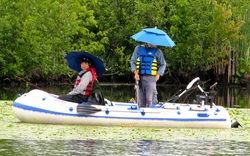
Umbrella hats? Practical but fashionable, are they the next fashion to sweep the country?
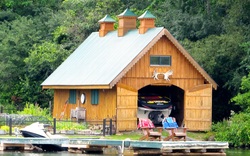
An appropriate companion to "Cottages" to hold all the stuff and notice the antlers above the door.
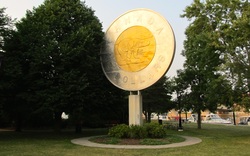
It is not a sundial or a tribute to an alien spaceship. The designer of Canada's two dollar coin came from this town who erect this monument in his honor.
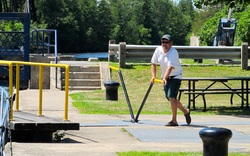
These lock doors are opened and closed manually. These Park Canada employees get their exercise and are multi-talented. No electricity or hydraulics, just human-power.
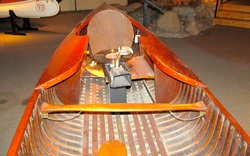
A canoe that has all the comforts including a record player.
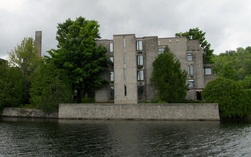
Is it Trent University or a modern medieval monastery? Which one would you send your child to?
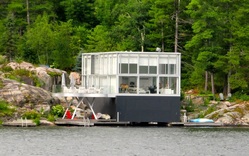
In a region of older and contemporary cottages, here is one so unique that is referenced in the guidebooks as an aid to navigation.
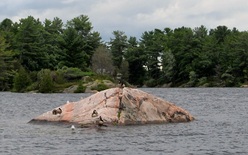
A granite "bumper" in Devil's Elbow. No room for a navigational error.
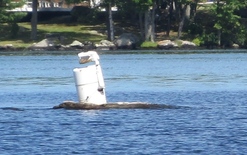
What is the name of this rock? If you guessed Washtub, you were right.
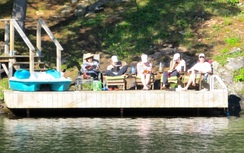
The boat judges and their morning coffee. Where are their score cards?
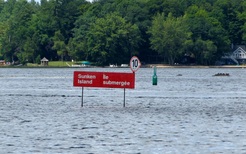
Self-explanatory.
